You are using an out of date browser. It may not display this or other websites correctly.
You should upgrade or use an alternative browser.
You should upgrade or use an alternative browser.
Exploring Colorado Becomes Redhead Down
- Thread starter turbodb
- Start date
turbodb
Well-known member
Redhead Down #6: Chihuahua, Webster, Red Cone and Radical!
As it seems many of our nights in Colorado were, this one was a cold one. Camped at 10,400', that was probably to be expected, but I didn't expect my packaged of baby wipes to be frozen in the morning, and my morning clean-up wasn't a pleasant experience given that they were.
But the elevation did make for a nice sky at sunrise - for that, I was grateful.

And, with another day - or morning as it'd turn out - of clear blue skies above, it didn't take long for the sun to warm camp up enough that we all ventured out of our tents to greet the new day.


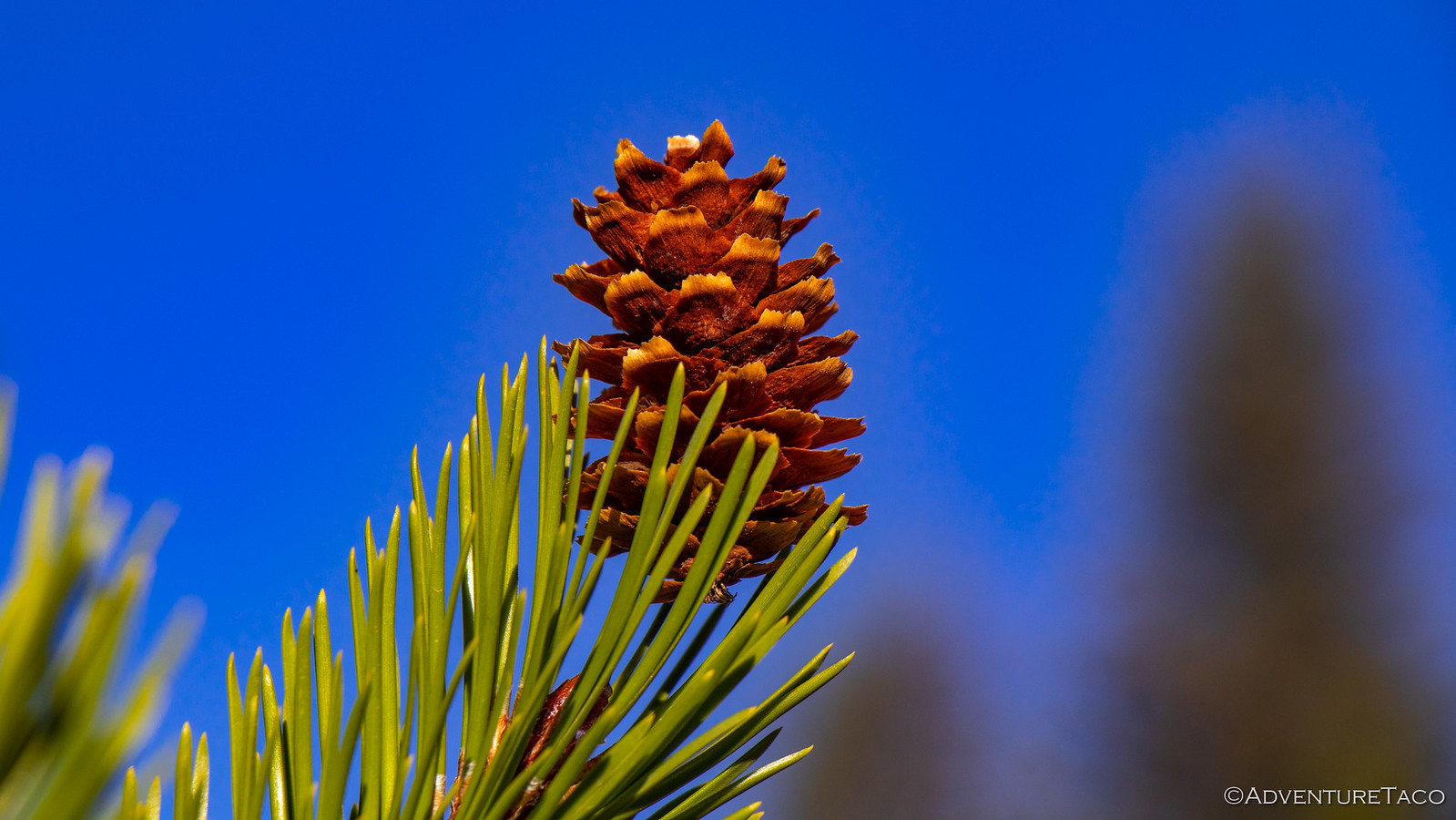
In fact, this was the day we'd all been waiting for - it was the first day (of many, we hoped) that we'd really experience the grandeur of Colorado's mountains. And, it was the first day that we'd get some technical wheeling under our tires.
Eager to get underway, we made quick work of breakfast and breakdown of camp, and soon we were on the road - our camp site only a few hundred yards from the first short trail we were tackling on the day: Chihuahua Gulch.

Chihuahua Gluch is a short and enjoyable trail that climbs into and then through a valley below two of Colorado's 14,000-ft peaks - Grays and Torreys Peak. As we broke through the dense treeline into the valley, I remarked over the CB that I probably hadn't needed to stop a few hundred feet downhill to take a bunch of photos!


At just over two miles each way, though the trail is a relatively short one, the scenery does not disappoint - packing a lot into that short distance. And the trail itself is fun too - the terrain varied, offering flexy sections, rocks, and even several easy water crossings.



We reached the end relatively quickly and after a few minutes saying hi to hikers who were on their way to bag a "14er" or two, we got our rigs turned around and headed back the way we'd come, our next destination just a few miles up the main road.
We arrived at the Pennsylvania Mine to a lot full of cars, but were pleasantly surprised to find that we were - for the moment - the only people exploring the mine; everyone else off on a hike or other adventure, leaving us in peace.
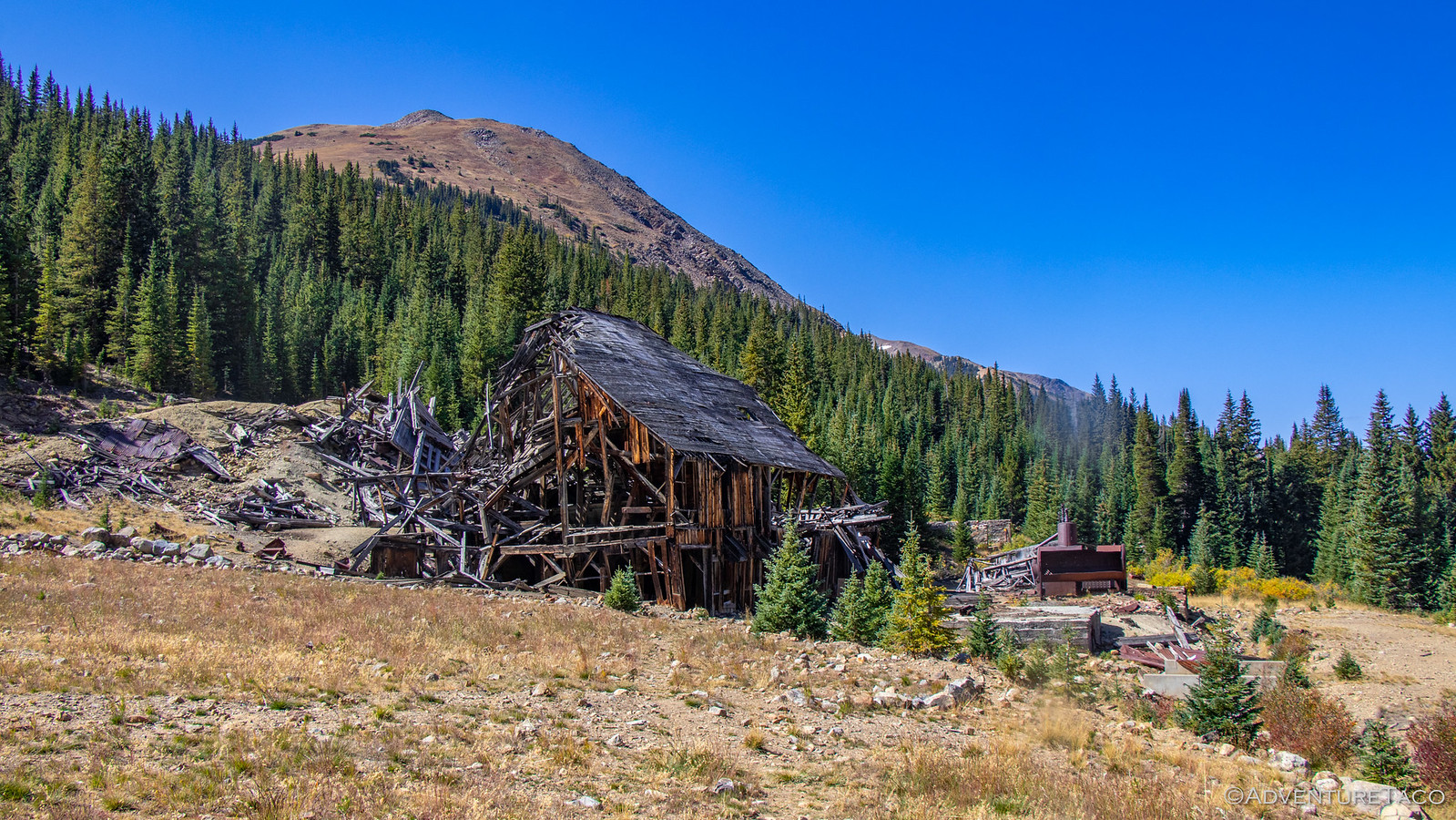
This mine was a rich producer of gold and silver in Colorado, it's best year occurring in 1893 - the year of the great silver crash. It continued to operate through the crash, producing $3,000,000 in earnings between 1893 and 1898. A major source of pollution for the water in nearby Peru Creek, several cleanup efforts have occurred over the years and are now complete. (from Funtreks Guide to Colorado Backroads & 4-Wheel-Drive Trails)



Not only was the mill still in remarkably good condition for its close proximity to a major road and lots of human traffic, but there were tons of cool old artifacts to check out as well. The boilers made of 1" thick steel - a little cattywampus, the smelter - ready to melt silver for bars, and two old pistons that powered a huge drive belt - relics from Ingersol Rand.



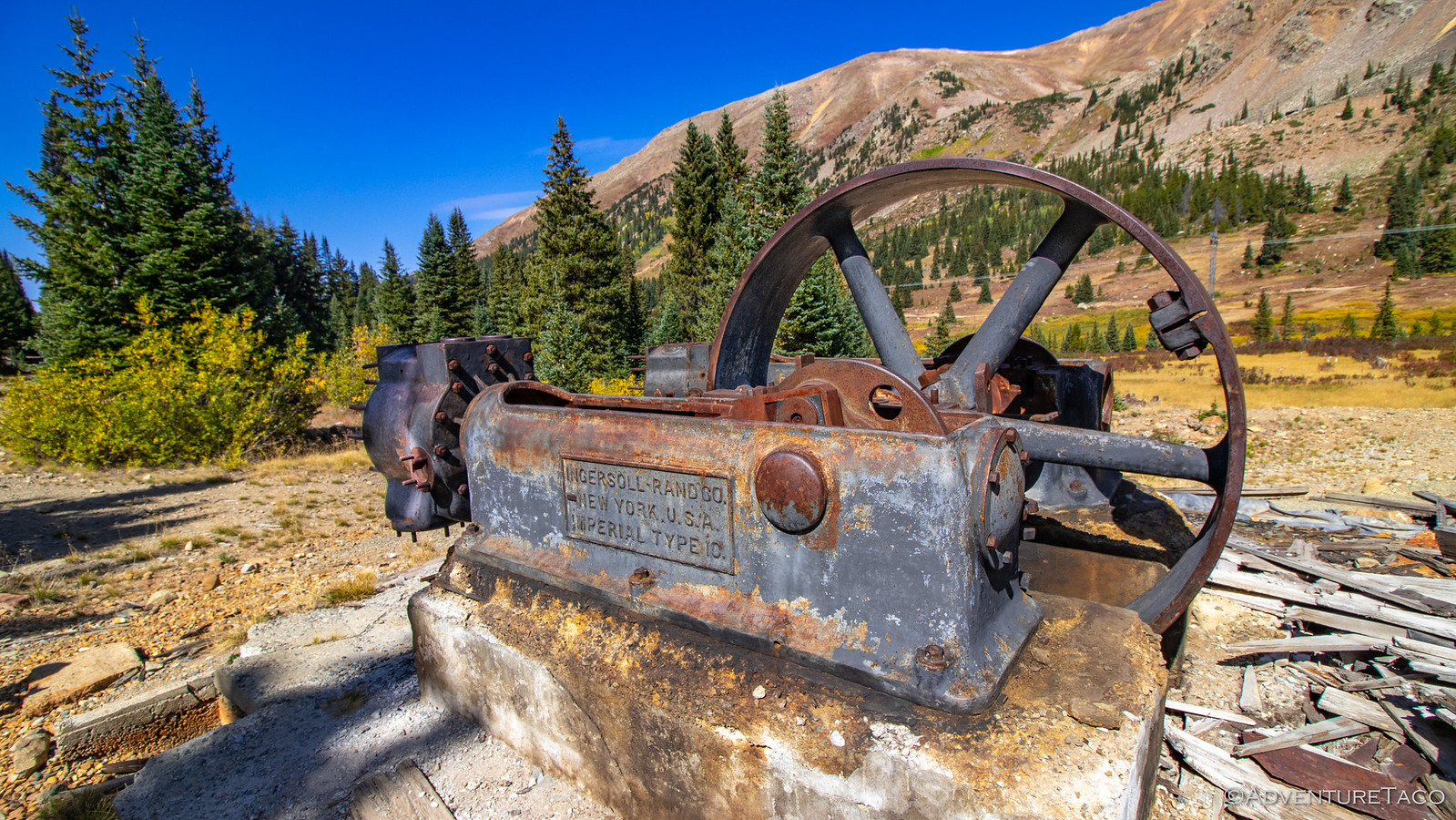
It took us a while to get our fill of these ruins, but eventually we pulled ourselves back to the trucks that were biding their time in the parking area, like cats ready to pounce.
Don't miss the rest of the story, and all the remaining photos that don't fit here (due to max post size). Hopefully that can change in the future, but until then...
.
As it seems many of our nights in Colorado were, this one was a cold one. Camped at 10,400', that was probably to be expected, but I didn't expect my packaged of baby wipes to be frozen in the morning, and my morning clean-up wasn't a pleasant experience given that they were.
But the elevation did make for a nice sky at sunrise - for that, I was grateful.

And, with another day - or morning as it'd turn out - of clear blue skies above, it didn't take long for the sun to warm camp up enough that we all ventured out of our tents to greet the new day.



In fact, this was the day we'd all been waiting for - it was the first day (of many, we hoped) that we'd really experience the grandeur of Colorado's mountains. And, it was the first day that we'd get some technical wheeling under our tires.
Eager to get underway, we made quick work of breakfast and breakdown of camp, and soon we were on the road - our camp site only a few hundred yards from the first short trail we were tackling on the day: Chihuahua Gulch.

Chihuahua Gluch is a short and enjoyable trail that climbs into and then through a valley below two of Colorado's 14,000-ft peaks - Grays and Torreys Peak. As we broke through the dense treeline into the valley, I remarked over the CB that I probably hadn't needed to stop a few hundred feet downhill to take a bunch of photos!


At just over two miles each way, though the trail is a relatively short one, the scenery does not disappoint - packing a lot into that short distance. And the trail itself is fun too - the terrain varied, offering flexy sections, rocks, and even several easy water crossings.



We reached the end relatively quickly and after a few minutes saying hi to hikers who were on their way to bag a "14er" or two, we got our rigs turned around and headed back the way we'd come, our next destination just a few miles up the main road.
We arrived at the Pennsylvania Mine to a lot full of cars, but were pleasantly surprised to find that we were - for the moment - the only people exploring the mine; everyone else off on a hike or other adventure, leaving us in peace.

This mine was a rich producer of gold and silver in Colorado, it's best year occurring in 1893 - the year of the great silver crash. It continued to operate through the crash, producing $3,000,000 in earnings between 1893 and 1898. A major source of pollution for the water in nearby Peru Creek, several cleanup efforts have occurred over the years and are now complete. (from Funtreks Guide to Colorado Backroads & 4-Wheel-Drive Trails)



Not only was the mill still in remarkably good condition for its close proximity to a major road and lots of human traffic, but there were tons of cool old artifacts to check out as well. The boilers made of 1" thick steel - a little cattywampus, the smelter - ready to melt silver for bars, and two old pistons that powered a huge drive belt - relics from Ingersol Rand.




It took us a while to get our fill of these ruins, but eventually we pulled ourselves back to the trucks that were biding their time in the parking area, like cats ready to pounce.
Don't miss the rest of the story, and all the remaining photos that don't fit here (due to max post size). Hopefully that can change in the future, but until then...
Keep reading the rest here
Redhead Down #6: Chihuahua, Webster, Red Cone and Radical!
Redhead Down #6: Chihuahua, Webster, Red Cone and Radical!
.
turbodb
Well-known member
Redhead Down #7: The Day We Made a Bench
Without a fire, it was another cold night and I was glad for my Little Hotties, their 8-hour life just long enough to keep my toes toasty until it was time to get up. And - at least for me - toasty toes are a key factor to the rest of my body being warm through the night, so I slept soundly as the surface of the beaver pond we'd parked by froze over night.



Of course, as the sun rose to our east - it's warmth streaming down on our camp - we all ventured out of our cocoons to check out camp and start our new day. Mike @Digiratus got started on his coffee, Monte @Blackdawg and I made our usual morning photo rounds, and Brett @Squeaky Penguin got right down to work with his fly rod. It was another fun morning!

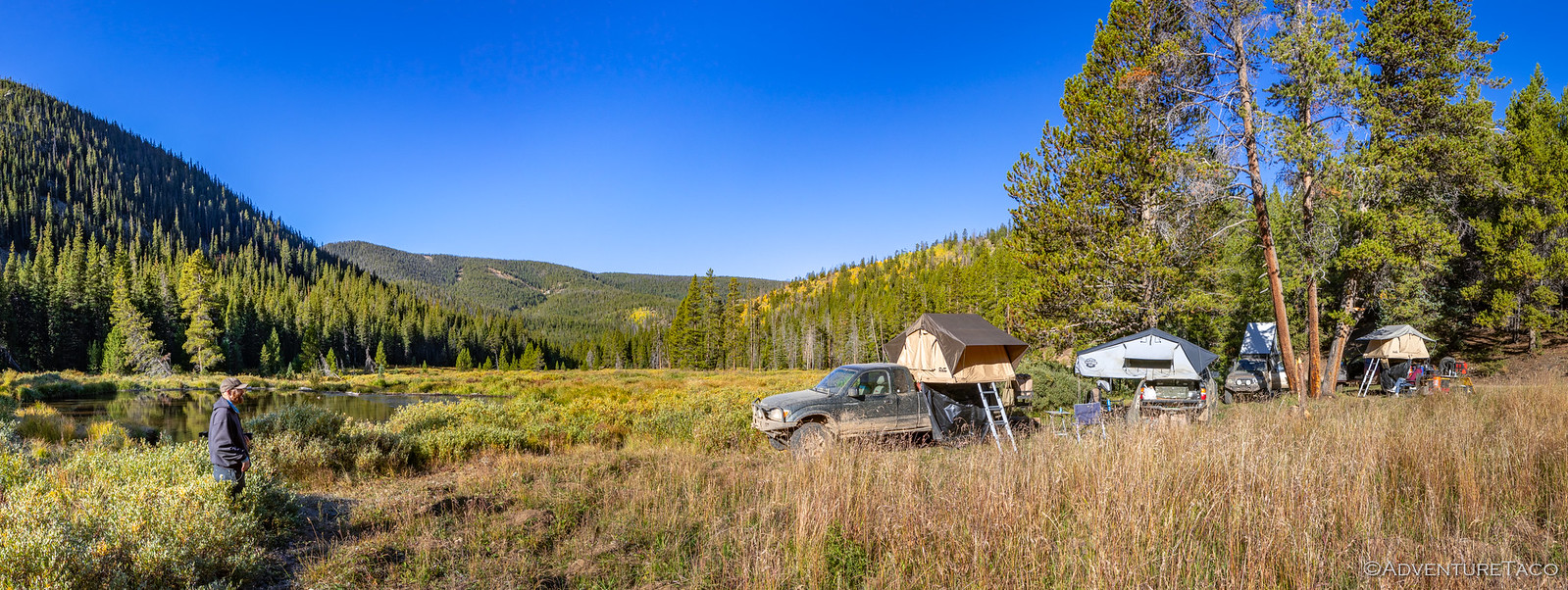

Our plan for the day - though not as ambitious as the last - was going to have us traversing some reasonably cool passes, and hitting up a fancy spot for lunch, we set about breakfast and were ready to get out of camp an hour or so after climbing down our ladders. The cold night had done nothing to reduce the dusty conditions, our liberal use of skinny pedals kicking up the find powder as we sped up the road. We were on our way to Georgia Pass.

One of three passes over the Continental Divide in Summit County, Georgia Pass is well traveled - but not as well traveled as the other two routes. One - Webster Pass - we'd done the day before, and the other - Boreas Pass - was next on our list. It turns out that because Georgia is less difficult than Webster, and more difficult than Boreas, it simply doesn't appeal to either the hard core offroaders or the city slickers, and that meant that as we climbed the pass from the north, we had it mostly to ourselves!

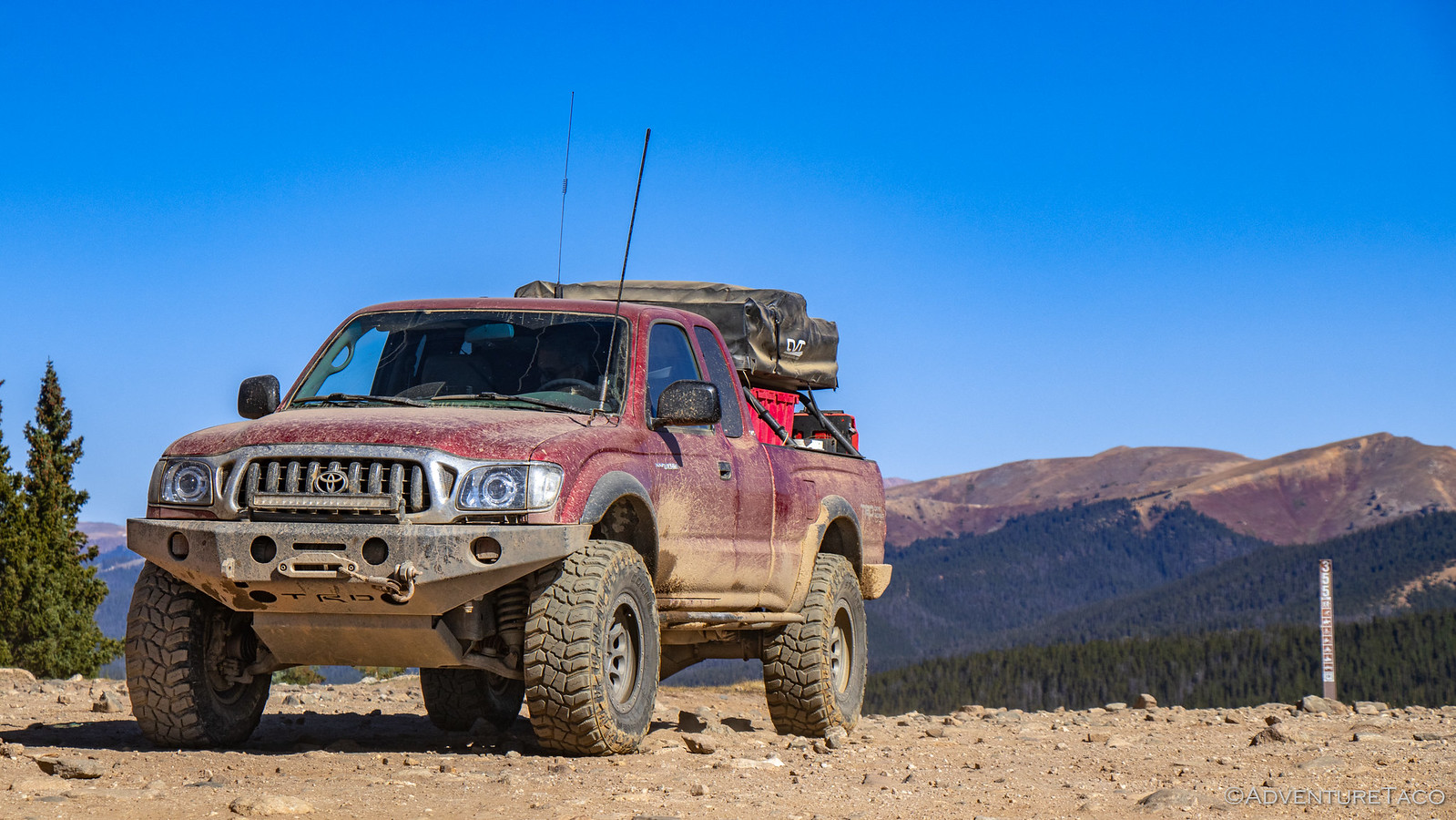
Georgia Pass wasn't always so sparsely traveled. It once served as the primary route into the Swan and Blue river valleys for gold-hungry miners with as many as 200 prospectors a day flooding over the pass - then called Swan River Pass - into the boom towns of Parkville, Swandyke, and Tiger. No trace remains of these once vibrant towns except for a few ruins in Swandyke, since Parkville was buried by river dredges in the 1880s, and Tiger was intentionally burned to the ground by the Forest Service in the 1970s to "rid the area of squatters." By the 1880s, Boreas and Hoosier passes had become easier and more civilized routes and Georgia Pass was all but abandoned.
Today, a sign informing travelers of the Continental Divide decorates the summit - dropping a bit of knowledge on passing visitors.


The trip along - and for us down - the southern flank of Georgia Pass is much easier than the north, and we reached some reasonably high speeds as we slalomed down the well graded gravel road. As we did, Mount Guyot rose in the front of us, it's two-tone ridge striking above the green tress and against the blue sky.

Racing to catch up after a few stops for photos, I finally caught the trailing dust as we approached the tiny town of Como, CO. Formed in 1879,it was the location of a train depot for the Denver, South Park, and Pacific Railroad to reach the silver mines in the area. It was striking as we drove through, how many of the old structures seemed to remain - an old roundhouse - notable among them.
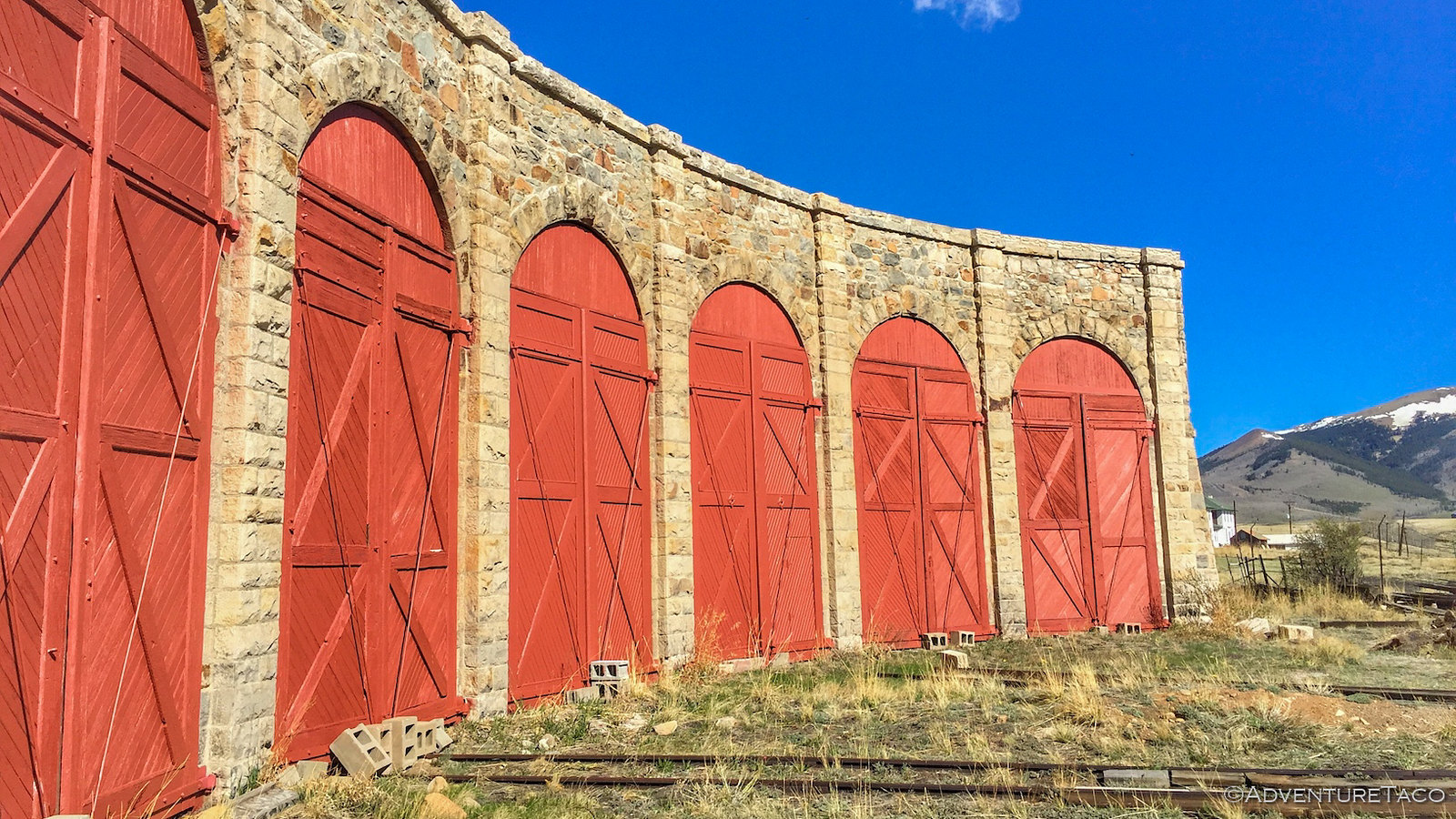
If we'd stopped, we probably could have spent a good chunk of time in Como - several of the houses painted vibrant colors that would have been the subject of our cameras, several other historic buildings worth a look. But that would be left for another day - today we had plenty to keep us busy, and a lunch date to keep in our next "town." Between us and that lunch date was Boreas Pass - the pass an astute reader may recall as the easiest one over the Continental Divide.
Things started off smoothly enough as we climbed Boreas from the south - traffic was light, the road was smooth, and the miles fell away behind us as we climbed toward the tree line.

But then - about halfway up - things changed. First, we caught up to a single vehicle; then two. Before long, we were the last four travelers in a string of cars and trucks nearly 20 strong. And we were going slow. This of course was somewhat understandable - I mean, how fast is a Tesla, really? The bigger problem for us was that - while we wanted to, and could, go faster - everyone else seemed content to make their way slowly along, diving in the dead center of what was clearly a 2 lane road. It was frustrating to say the least, though it did give me time - as the last one in line - to stop and take leisurely photos of our approach. Ultimately we did reach the top, but as soon as we did - and all of the cars pulled over to explore the artifacts there - we pressed our skinny pedals to the floor, trying to jump out in front.

Our strategy worked for about 3 minutes. As you can imagine if you give it just a little bit of though - the parade of vehicles on this road is rather constant. So, while we may have skipped ahead of the 11:00am crowd, we still had the 10:45am folks to contend with as we descended the north side of the pass. And probably the 10:30am and 10:15am groups in front of them. Needless to say, it was slow going, and there may have been some frustrated venting by certain members of our group when the city-folk weren't the most astute drivers in this environment.
Still in the back of the pack - and frankly hanging back a little extra to stay out of the dust - I continued to stop frequently to try to capture the beauty this place had to offer, even as its crowds frustrated those used to travelling faster. Because it was definitely turning to fall, and the colors were amazing!
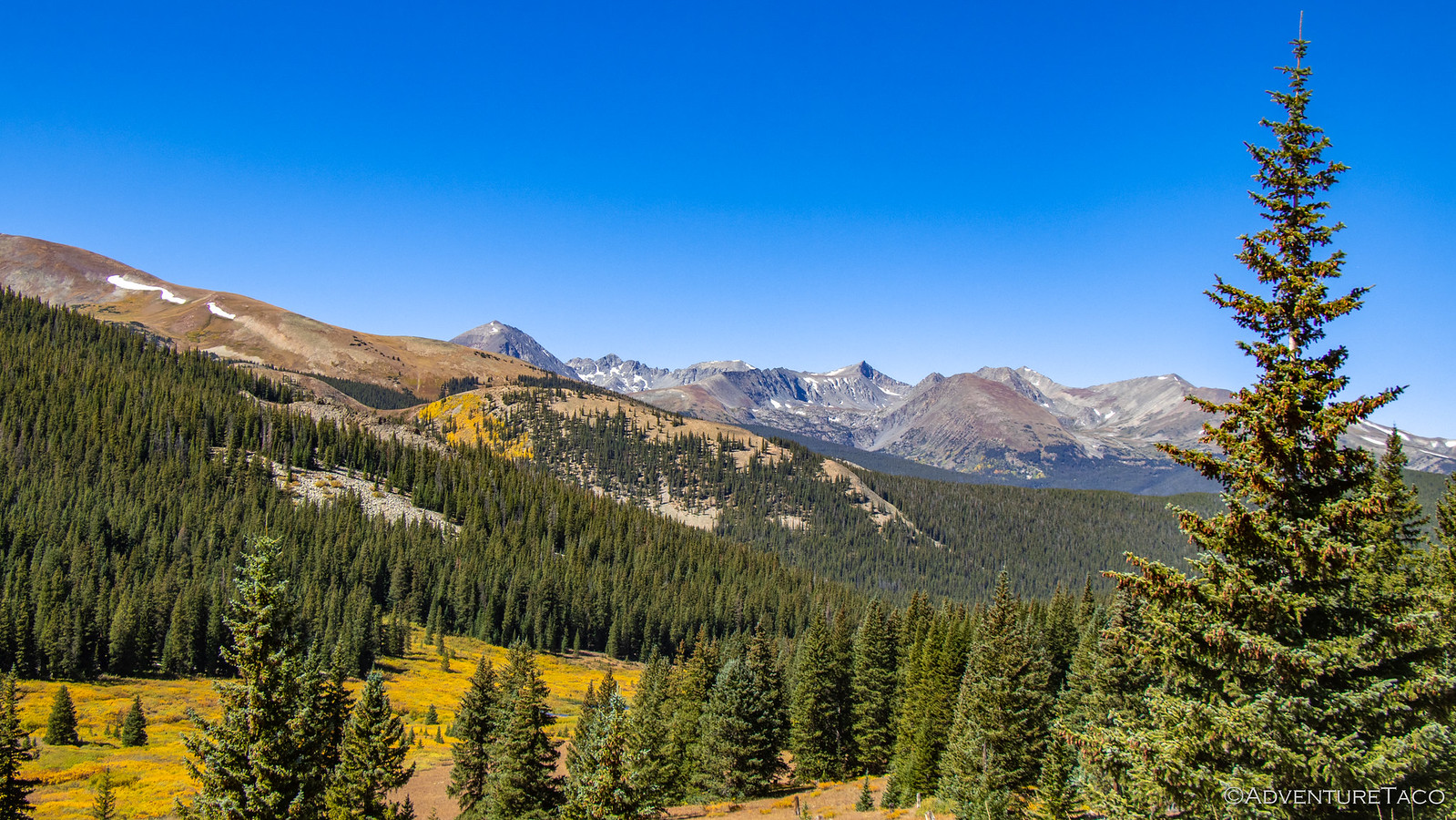
Half an hour later, we found ourselves pulling into Breckenridge - the ski slopes bare for the time being, but the town still hopping with summer tourists. Here, we fueled up and then scrambled for free parking so we could enjoy the lunch date we'd decided on the evening before: The Breckenridge Brewery.
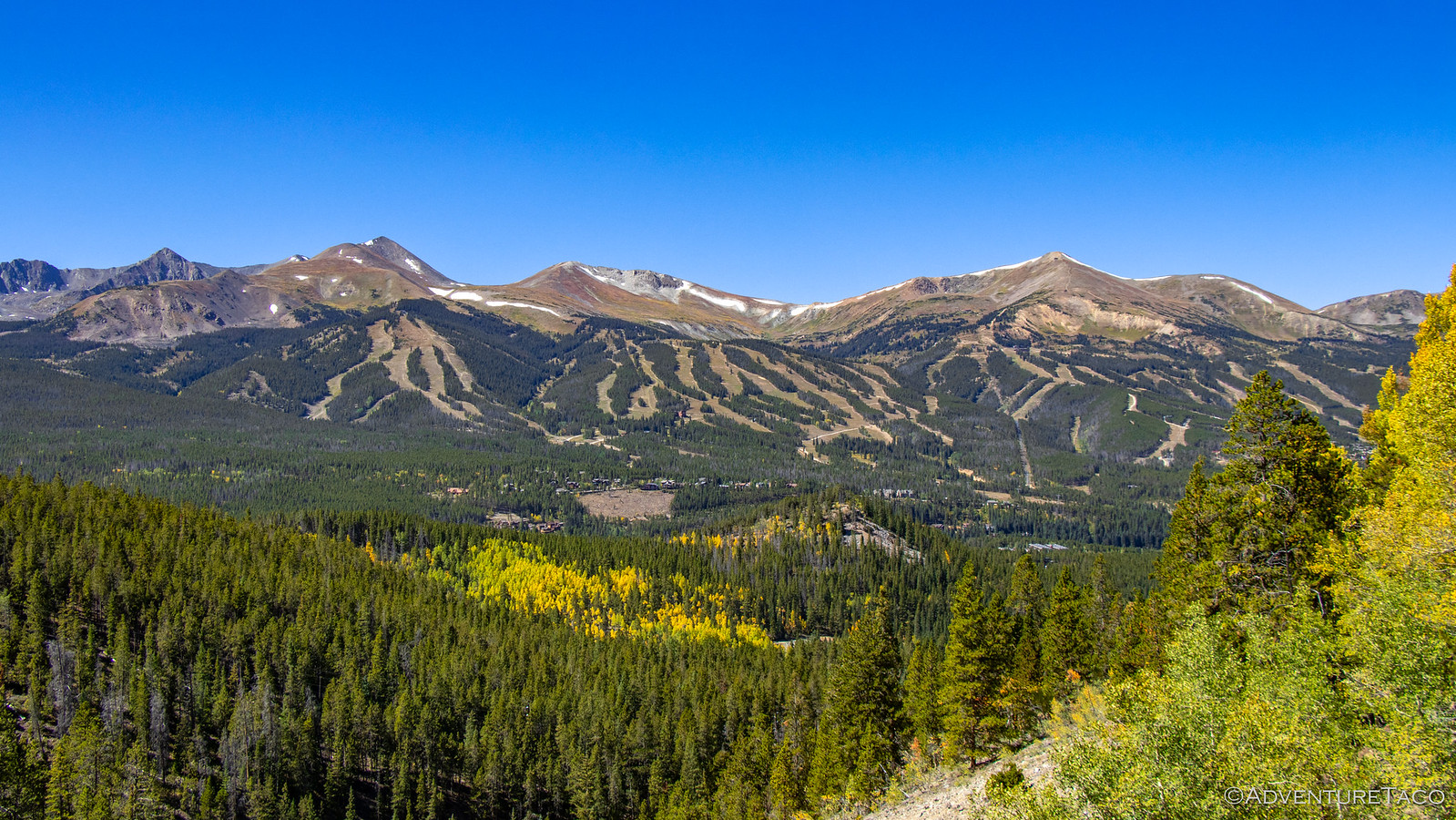

Lunch there was about what you'd expect - in my opinion - for a posh, tourist town: just OK. It was however a nice stop with a bunch of good company, a nice break from doing everything for ourselves. I think though, that we were all ready to be back on the trail by the time lunch was over and we'd each paid our checks - our wallets now lighter than our stomachs!
It turned out that Brett had a bit of a surprise in store for us as we pulled out of town, announcing that there were a couple of really cool trails in the area, and that we should go check out one in particular - Crystal Lake. He wasn't sure of the exact turn off from the highway, but we found it easily enough and drove through a reasonably large residential neighborhood before coming to the trailhead. From there, it was stunning how quickly the terrain changed - the graded gravel road almost instantly rocky and high-clearance only. It was great, and we soon found ourselves nearing the treeline again as we flirted with 11,500'!
Don't miss the rest of the story, and all the remaining photos that don't fit here (due to max post size). Hopefully that can change in the future, but until then...
.
Without a fire, it was another cold night and I was glad for my Little Hotties, their 8-hour life just long enough to keep my toes toasty until it was time to get up. And - at least for me - toasty toes are a key factor to the rest of my body being warm through the night, so I slept soundly as the surface of the beaver pond we'd parked by froze over night.



Of course, as the sun rose to our east - it's warmth streaming down on our camp - we all ventured out of our cocoons to check out camp and start our new day. Mike @Digiratus got started on his coffee, Monte @Blackdawg and I made our usual morning photo rounds, and Brett @Squeaky Penguin got right down to work with his fly rod. It was another fun morning!



Our plan for the day - though not as ambitious as the last - was going to have us traversing some reasonably cool passes, and hitting up a fancy spot for lunch, we set about breakfast and were ready to get out of camp an hour or so after climbing down our ladders. The cold night had done nothing to reduce the dusty conditions, our liberal use of skinny pedals kicking up the find powder as we sped up the road. We were on our way to Georgia Pass.

One of three passes over the Continental Divide in Summit County, Georgia Pass is well traveled - but not as well traveled as the other two routes. One - Webster Pass - we'd done the day before, and the other - Boreas Pass - was next on our list. It turns out that because Georgia is less difficult than Webster, and more difficult than Boreas, it simply doesn't appeal to either the hard core offroaders or the city slickers, and that meant that as we climbed the pass from the north, we had it mostly to ourselves!


Georgia Pass wasn't always so sparsely traveled. It once served as the primary route into the Swan and Blue river valleys for gold-hungry miners with as many as 200 prospectors a day flooding over the pass - then called Swan River Pass - into the boom towns of Parkville, Swandyke, and Tiger. No trace remains of these once vibrant towns except for a few ruins in Swandyke, since Parkville was buried by river dredges in the 1880s, and Tiger was intentionally burned to the ground by the Forest Service in the 1970s to "rid the area of squatters." By the 1880s, Boreas and Hoosier passes had become easier and more civilized routes and Georgia Pass was all but abandoned.
Today, a sign informing travelers of the Continental Divide decorates the summit - dropping a bit of knowledge on passing visitors.


The trip along - and for us down - the southern flank of Georgia Pass is much easier than the north, and we reached some reasonably high speeds as we slalomed down the well graded gravel road. As we did, Mount Guyot rose in the front of us, it's two-tone ridge striking above the green tress and against the blue sky.

Racing to catch up after a few stops for photos, I finally caught the trailing dust as we approached the tiny town of Como, CO. Formed in 1879,it was the location of a train depot for the Denver, South Park, and Pacific Railroad to reach the silver mines in the area. It was striking as we drove through, how many of the old structures seemed to remain - an old roundhouse - notable among them.

If we'd stopped, we probably could have spent a good chunk of time in Como - several of the houses painted vibrant colors that would have been the subject of our cameras, several other historic buildings worth a look. But that would be left for another day - today we had plenty to keep us busy, and a lunch date to keep in our next "town." Between us and that lunch date was Boreas Pass - the pass an astute reader may recall as the easiest one over the Continental Divide.
Things started off smoothly enough as we climbed Boreas from the south - traffic was light, the road was smooth, and the miles fell away behind us as we climbed toward the tree line.

But then - about halfway up - things changed. First, we caught up to a single vehicle; then two. Before long, we were the last four travelers in a string of cars and trucks nearly 20 strong. And we were going slow. This of course was somewhat understandable - I mean, how fast is a Tesla, really? The bigger problem for us was that - while we wanted to, and could, go faster - everyone else seemed content to make their way slowly along, diving in the dead center of what was clearly a 2 lane road. It was frustrating to say the least, though it did give me time - as the last one in line - to stop and take leisurely photos of our approach. Ultimately we did reach the top, but as soon as we did - and all of the cars pulled over to explore the artifacts there - we pressed our skinny pedals to the floor, trying to jump out in front.

Our strategy worked for about 3 minutes. As you can imagine if you give it just a little bit of though - the parade of vehicles on this road is rather constant. So, while we may have skipped ahead of the 11:00am crowd, we still had the 10:45am folks to contend with as we descended the north side of the pass. And probably the 10:30am and 10:15am groups in front of them. Needless to say, it was slow going, and there may have been some frustrated venting by certain members of our group when the city-folk weren't the most astute drivers in this environment.
Still in the back of the pack - and frankly hanging back a little extra to stay out of the dust - I continued to stop frequently to try to capture the beauty this place had to offer, even as its crowds frustrated those used to travelling faster. Because it was definitely turning to fall, and the colors were amazing!

Half an hour later, we found ourselves pulling into Breckenridge - the ski slopes bare for the time being, but the town still hopping with summer tourists. Here, we fueled up and then scrambled for free parking so we could enjoy the lunch date we'd decided on the evening before: The Breckenridge Brewery.


Lunch there was about what you'd expect - in my opinion - for a posh, tourist town: just OK. It was however a nice stop with a bunch of good company, a nice break from doing everything for ourselves. I think though, that we were all ready to be back on the trail by the time lunch was over and we'd each paid our checks - our wallets now lighter than our stomachs!
It turned out that Brett had a bit of a surprise in store for us as we pulled out of town, announcing that there were a couple of really cool trails in the area, and that we should go check out one in particular - Crystal Lake. He wasn't sure of the exact turn off from the highway, but we found it easily enough and drove through a reasonably large residential neighborhood before coming to the trailhead. From there, it was stunning how quickly the terrain changed - the graded gravel road almost instantly rocky and high-clearance only. It was great, and we soon found ourselves nearing the treeline again as we flirted with 11,500'!
Don't miss the rest of the story, and all the remaining photos that don't fit here (due to max post size). Hopefully that can change in the future, but until then...
Keep reading the rest here
Redhead Down #7: The Day We Made a Bench
Redhead Down #7: The Day We Made a Bench
.
turbodb
Well-known member
Redhead Down #8: Exploring the Champion Mill
Having gone to bed late, and camped at the bottom of a valley between two, 13,000' peaks that kept the sun from hitting camp, everyone was up relatively late the next morning.
Mostly.
I just happened to wake up and look out the tent door when the sun was in that special place below the horizon and lucked out capturing what I think was probably the best - or at least most colorful - sunrise of the trip!



But I was then back in the tent for another couple hours, doing my darnedest to keep warm as the cloud cover thickened. Eventually of course, we were all up and about - the day's journey awaiting our departure. It was at this point - as Monte was wondering how long it'd take him to make it back up the trail through Birdseye Gulch - that Brett informed us that, and then chuckled, "We don't need to go back up. Wait, you guys didn't realize that we're continuing down?"
Uh, nope. We're not from around here, Brett! : :
:
Happy to hear that our route out may not take a couple of hours, we decided it was high time for a morning break from wheeling.
No, that doesn't make sense, we hadn't done any wheeling yet. Regardless, someone had found a frisbee plastered with stickers from the Boise Idaho Jeep Club in the nearby creek and we proceeded to have a great time tossing it around for a good half hour or so before stashing where it belonged - it in a Trasharoo.
Eventually we all piled into our trucks and continued down the trail we'd started the evening before, the rocks and flexy sections just as frequent as they'd been on the way down.
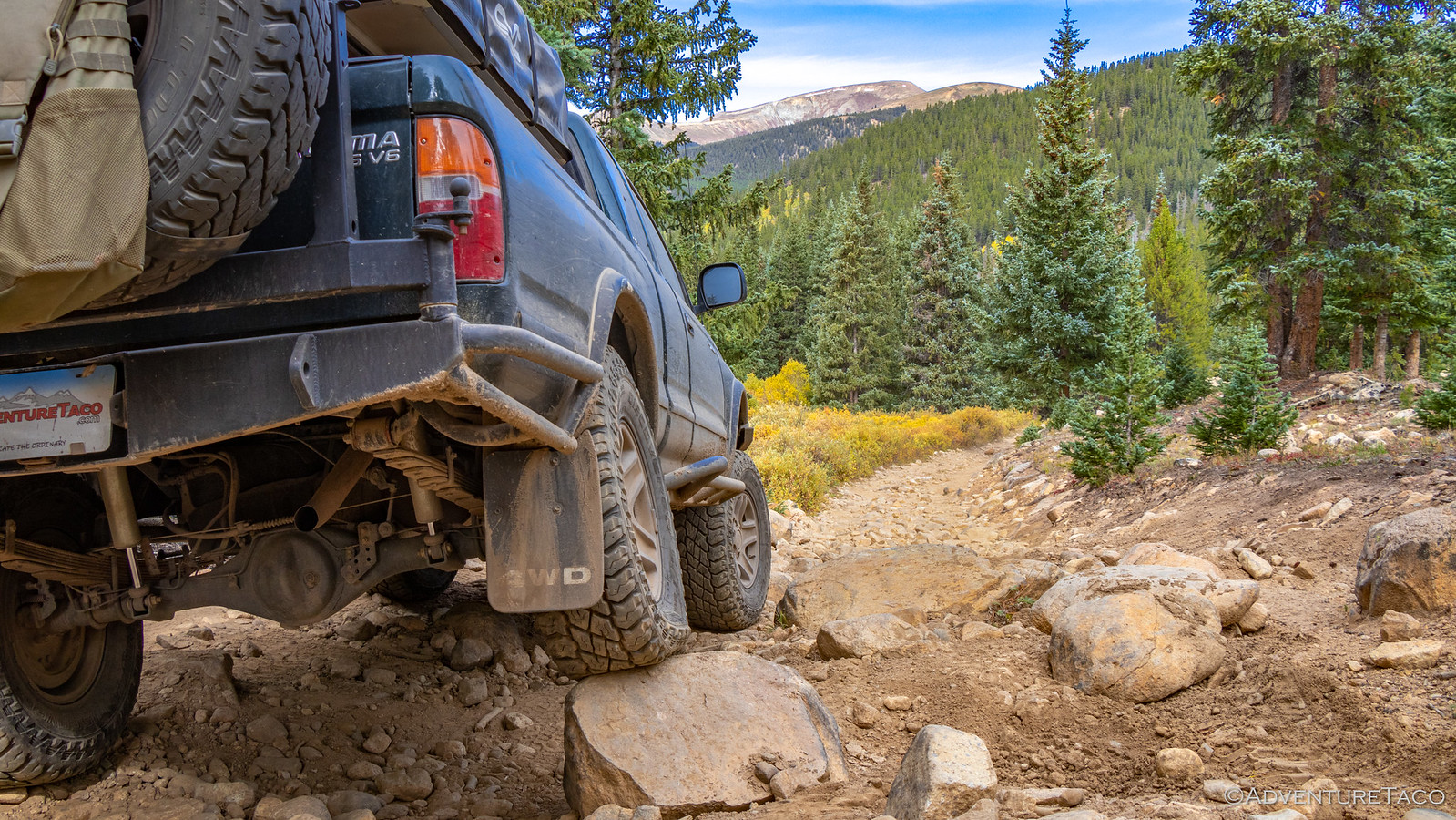
As we descended toward CO-91 and ultimately Leadville, we crossed numerous streams that showed just how cold it'd gotten the night before - because it's not a balmy 32°F morning that results in 5" long icicles!

And then, we crossed something that we've never - to my recollection - crossed in the wild before: train tracks. I mean, we cross these all the time on paved roads, and we see old abandoned mine rail lines all the time. But to run into an active rail out here in the middle of nowhere - it was a little surreal, and we waited around for a few minutes to see if we could get lucky and see a train. (Nope.)
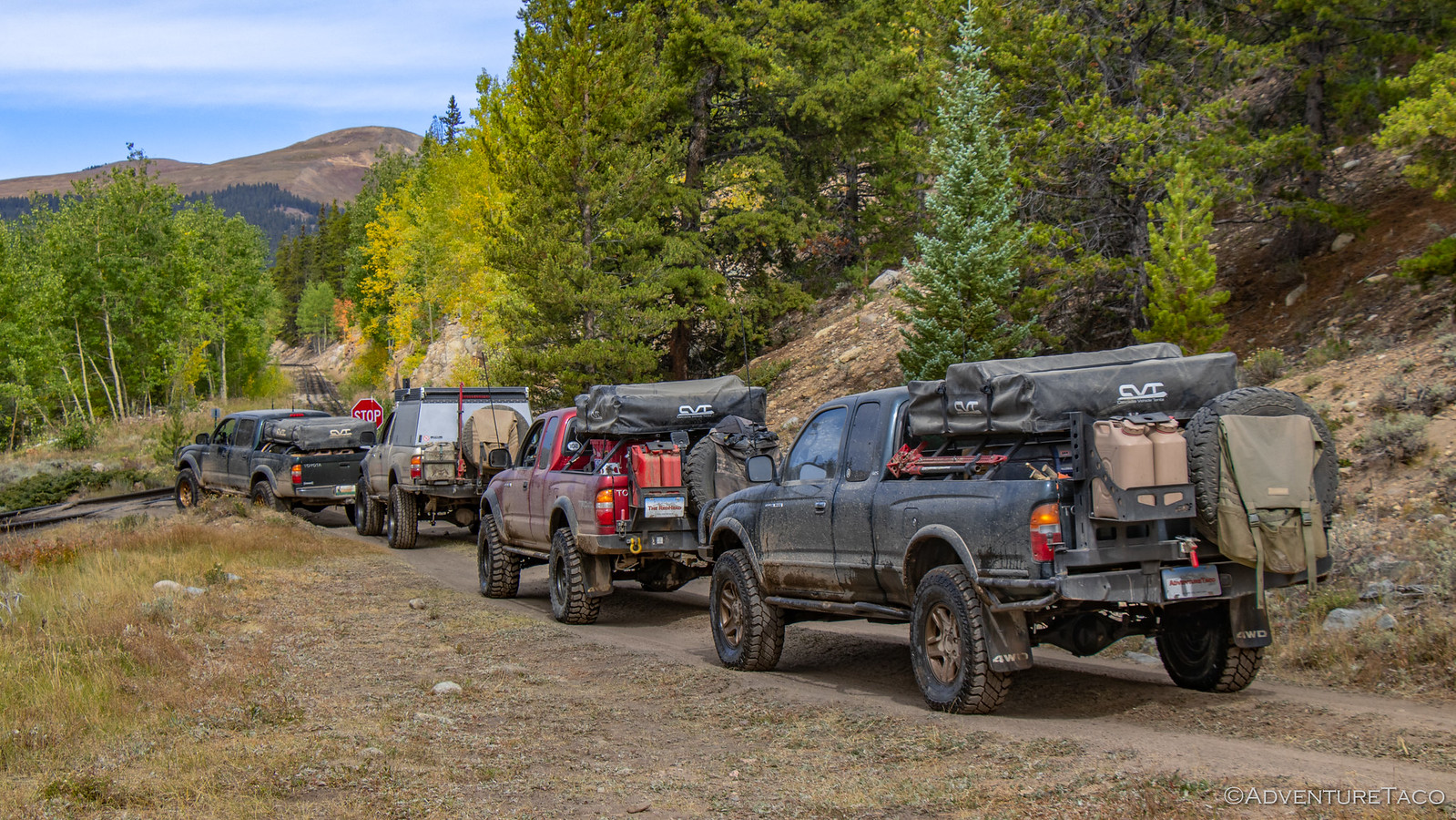


From there, the dirt road down to the CO-91 highway got remarkably better. There were still a few water crossings and slower sections, but all-in-all, we were definitely back in Subaru territory. And once we hit the highway, it was a short jaunt into Leadville.

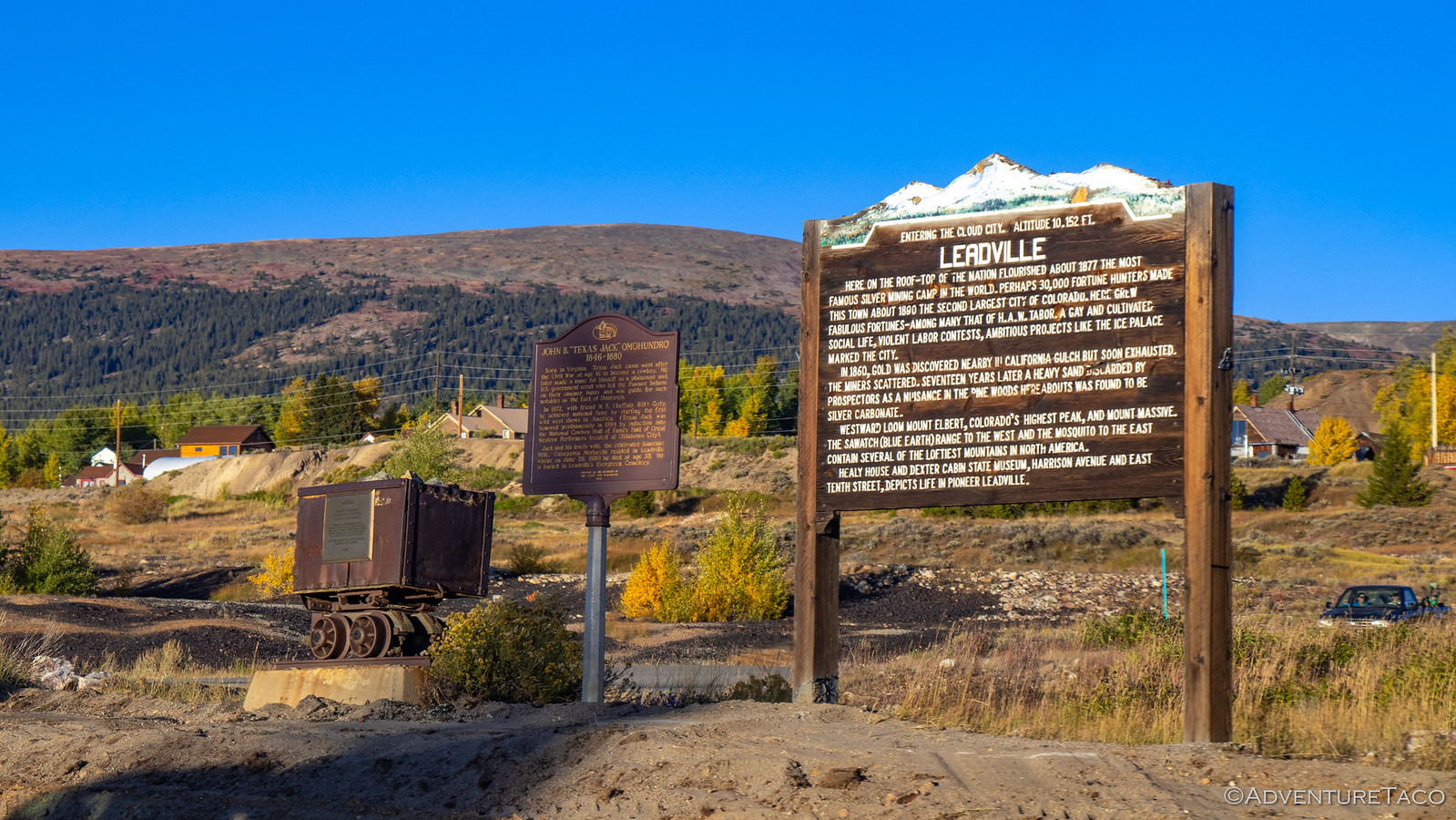
There's no better description of Leadville than that carved into the sign at the edge of town, so rather than paraphrase, I'll just include it here:
As we drove through the town itself, it's quaint main street reminded me of the town of Wallace, Idaho, the buildings old, but in remarkable condition.

Still with plenty of fuel, we didn't even stop as we passed through town - our eyes set on a destination that we'd been waiting several days to enjoy: the Champion Mine and Mill. And it was up at the top of this mountain. :biggrin:

Soon off pavement, we headed up the trail - the forest here completely void of any undergrowth. I commented on this fact over the CB radio, and Brett came back to say that so many people camped here as they staged to climb a 14er, that they essentially trampled anything shorter than 30 ft tall.
Well, that was a bit of a bummer, but looking back now I realize that despite the heavy traffic, there wasn't hardly a piece of trash in sight - so at least that's a reasonably good thing!
The further we got from town, the more rustic the trail became, avalanche shoots showing themselves as scars on the mountainsides, reasonably deep water-crossings serving as gatekeepers for the remainder of the trail...and a car wash for our amazing wheels.


Soon enough, we were once again making our way up and out of the treeline, our trucks and their drivers breathing in the cool, clear mountain air.


As we got closer to the mill, Brett let us know that there'd recently been a bit of controversy over whether or not it was OK to drive up to the mill itself. Apparently the road was gated and - logically - the Forest Service said that if the gate was open, it was fine to drive up; otherwise, the road should be considered closed to motor vehicles.
We all hoped we'd find the gate open. Predictably, it was closed. out: Undeterred, we parked our trucks and set off on foot.
out: Undeterred, we parked our trucks and set off on foot.
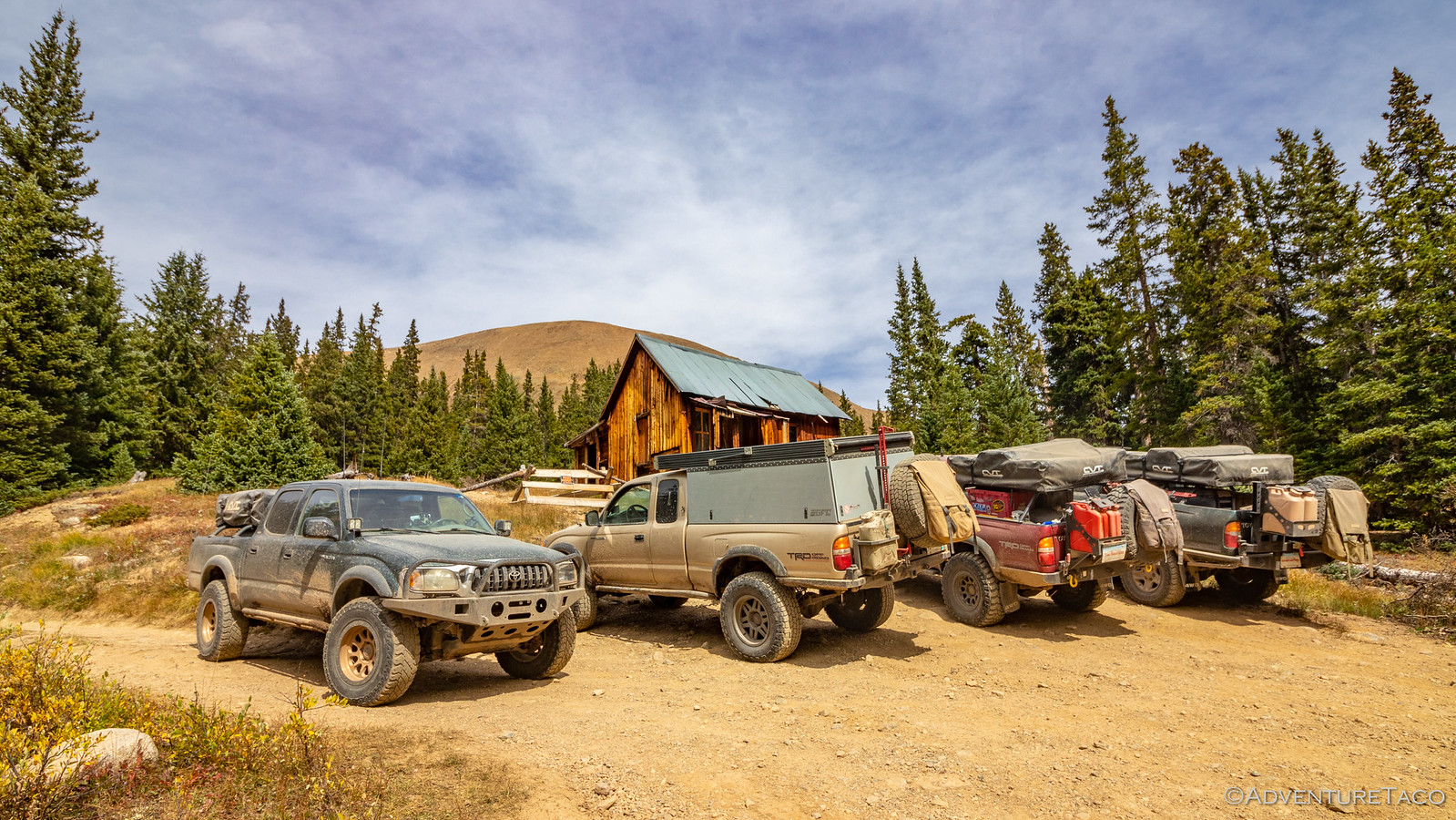
The Champion Mine was developed in 1907 when the Mount Champion Mining Company purchased the property and started construction mill capable of processing 50-tons per day and a 6,100 ft. long tramline - the first to pass over the crest of a ridge with an altitude over 13,600 ft at its highest point. Tram towers were constructed of wood and varied in height and design to follow the curvature of the cable strung between them. Electricity brought from Leadville powered the tram, which was equipped with forty-two buckets - each weighing 600 lbs and capable of holding nine cubic feet of ore which was shipped directly to the smelters in Leadville.
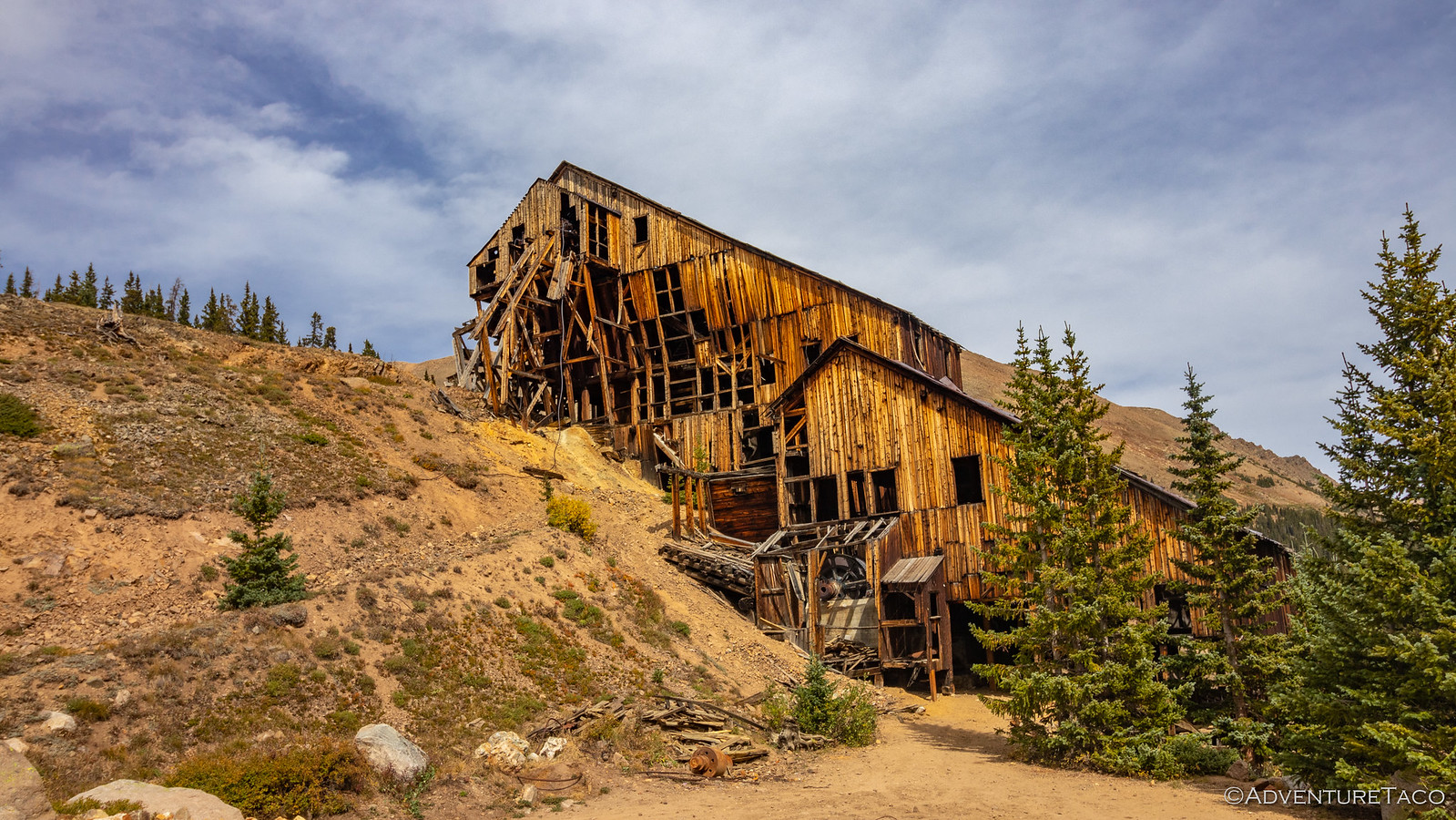
Significant production started in 1912 and continued until 1918 when the cost of shipping ore to Leadville smelters proved to be unprofitable. Today, the mill still stands tall, though long tough winters have obviously taken their toll. Clearly though, some renovation and preservation work has taken place recently - large steel cables and a few new wooden beams now helping to stabilize the leaning structure...
Don't miss the rest of the story, and all the remaining photos that don't fit here (due to max post size). Hopefully that can change in the future, but until then...
.
Having gone to bed late, and camped at the bottom of a valley between two, 13,000' peaks that kept the sun from hitting camp, everyone was up relatively late the next morning.
Mostly.
I just happened to wake up and look out the tent door when the sun was in that special place below the horizon and lucked out capturing what I think was probably the best - or at least most colorful - sunrise of the trip!



But I was then back in the tent for another couple hours, doing my darnedest to keep warm as the cloud cover thickened. Eventually of course, we were all up and about - the day's journey awaiting our departure. It was at this point - as Monte was wondering how long it'd take him to make it back up the trail through Birdseye Gulch - that Brett informed us that, and then chuckled, "We don't need to go back up. Wait, you guys didn't realize that we're continuing down?"
Uh, nope. We're not from around here, Brett! :
Happy to hear that our route out may not take a couple of hours, we decided it was high time for a morning break from wheeling.
No, that doesn't make sense, we hadn't done any wheeling yet. Regardless, someone had found a frisbee plastered with stickers from the Boise Idaho Jeep Club in the nearby creek and we proceeded to have a great time tossing it around for a good half hour or so before stashing where it belonged - it in a Trasharoo.
Eventually we all piled into our trucks and continued down the trail we'd started the evening before, the rocks and flexy sections just as frequent as they'd been on the way down.

As we descended toward CO-91 and ultimately Leadville, we crossed numerous streams that showed just how cold it'd gotten the night before - because it's not a balmy 32°F morning that results in 5" long icicles!

And then, we crossed something that we've never - to my recollection - crossed in the wild before: train tracks. I mean, we cross these all the time on paved roads, and we see old abandoned mine rail lines all the time. But to run into an active rail out here in the middle of nowhere - it was a little surreal, and we waited around for a few minutes to see if we could get lucky and see a train. (Nope.)



From there, the dirt road down to the CO-91 highway got remarkably better. There were still a few water crossings and slower sections, but all-in-all, we were definitely back in Subaru territory. And once we hit the highway, it was a short jaunt into Leadville.


There's no better description of Leadville than that carved into the sign at the edge of town, so rather than paraphrase, I'll just include it here:
Entering the cloud city. Altitude 10,152 ft. LEADVILLE
Here on the roof-top of the nation flourished about 1877 the most famous silver mining camp in the world. Perhaps 30,000 fortune hungers made this town the second largest city of Colorado in 1890. Here grew fabulous fortunes - among many, that of H.A.W. Tabor. A gay and cultivated social life, violent labor contests, ambitious projects like the ice palace marked the city.
In 1860, gold was discovered nearby in California Gulch but soon exhausted, the miners scattered. Seventeen years later, a heavy sand discarded by prospectors as nuisance in the pine woods here abouts was found to be silver carbonate.
Westward loomed Mt. Elbert, Colorado's highest peak, and Mt. Massive. The Sawatch (blue earth) Range to the west and the Mosquito to the east contain several of the loftiest mountains in North America.
As we drove through the town itself, it's quaint main street reminded me of the town of Wallace, Idaho, the buildings old, but in remarkable condition.

Still with plenty of fuel, we didn't even stop as we passed through town - our eyes set on a destination that we'd been waiting several days to enjoy: the Champion Mine and Mill. And it was up at the top of this mountain. :biggrin:

Soon off pavement, we headed up the trail - the forest here completely void of any undergrowth. I commented on this fact over the CB radio, and Brett came back to say that so many people camped here as they staged to climb a 14er, that they essentially trampled anything shorter than 30 ft tall.
Well, that was a bit of a bummer, but looking back now I realize that despite the heavy traffic, there wasn't hardly a piece of trash in sight - so at least that's a reasonably good thing!
The further we got from town, the more rustic the trail became, avalanche shoots showing themselves as scars on the mountainsides, reasonably deep water-crossings serving as gatekeepers for the remainder of the trail...and a car wash for our amazing wheels.


Soon enough, we were once again making our way up and out of the treeline, our trucks and their drivers breathing in the cool, clear mountain air.


As we got closer to the mill, Brett let us know that there'd recently been a bit of controversy over whether or not it was OK to drive up to the mill itself. Apparently the road was gated and - logically - the Forest Service said that if the gate was open, it was fine to drive up; otherwise, the road should be considered closed to motor vehicles.
We all hoped we'd find the gate open. Predictably, it was closed.

The Champion Mine was developed in 1907 when the Mount Champion Mining Company purchased the property and started construction mill capable of processing 50-tons per day and a 6,100 ft. long tramline - the first to pass over the crest of a ridge with an altitude over 13,600 ft at its highest point. Tram towers were constructed of wood and varied in height and design to follow the curvature of the cable strung between them. Electricity brought from Leadville powered the tram, which was equipped with forty-two buckets - each weighing 600 lbs and capable of holding nine cubic feet of ore which was shipped directly to the smelters in Leadville.

Significant production started in 1912 and continued until 1918 when the cost of shipping ore to Leadville smelters proved to be unprofitable. Today, the mill still stands tall, though long tough winters have obviously taken their toll. Clearly though, some renovation and preservation work has taken place recently - large steel cables and a few new wooden beams now helping to stabilize the leaning structure...
Don't miss the rest of the story, and all the remaining photos that don't fit here (due to max post size). Hopefully that can change in the future, but until then...
Keep reading the rest here
Redhead Down #8: Exploring the Champion Mill
Redhead Down #8: Exploring the Champion Mill
.
turbodb
Well-known member
Redhead Down #9: The Last Hour
The day started out like any other. I was up a little before sunrise looking for color, and while there wasn't much, I did get a little splash on the horizon that seemed to mimic the angle of Brett @Squeaky Penguin's GFC.

While the clear skies may have minimized the colorful sunrise, they did mean that morning in camp was a rather pleasant affair, the views back towards the Collegiate Peaks a striking way to enjoy the warming sun.

And then - just as we were enjoying the peace and tranquility and our trucks and tents were thawing out - a low-flying chopper buzzed our site. We still have no idea where he was headed, really - but we were sure that he hadn't made any friends with the elk hunters who were out in force!


Now, unlike most mornings, this wasn't one where our regular routines were going to suffice. I mean sure, Mike @Digiratus and Brett still made their coffee - and sure, our tents were all eventually put away. But between those two things, we took the time to cook a dozen eggs, a skillet full of potatoes, and two pounds of the most delicious Big Buy bacon.
And then - on Brett's last morning in camp - we feasted.

Of course, after any meal like that, a nap is the next item on the agenda. We didn't actually climb back in our tents, but we did sit around for a couple hours, soaking up the sun and enjoying each other's company as we watched a parade of UTVs and full-size pickups make their way slowly along the road.
It was after noon when Brett finally bid farewell, the rest of us not far behind as we pulled out of camp to get underway - our destination today to the south and east, as our fourth made his way north towards home.

Our southern route would take us to the tiny town of Tin Cup, and from there to Cumberland Pass. And, since I know it's on the top of your mind - let me assure you that our progress was no faster as a result of our late start - even Mike soaking up the fall colors that were blossoming around us.



Tin Cup was a town similar to Montezuma - it was small and quaint, it's roads made of dirt. Founded in 1878 when lode deposits were discovered in the area, it was originally named Virginia City. By the 1880 census, the town had a population of 1,495 but confusion with Virginia City, Nevada, and Virginia City, Montana, caused the residents to change the name to Tin Cup - named after prospector Jim Taylor panned some gold from Willow Creek, and carried it back to camp in a tin cup.
For many years, Tin Cup was a violent place. Town marshal Harry Rivers died in a gunfight in 1882, and marshal Andy Jameson was shot to death in 1883. The town population declined as the mines were exhausted and the post office closed in 1918, the last year any town elections were held. (wikipedia)

Through town, we started up Cumberland Pass, the additional height quickly giving us a birds eye view of the valley we'd just traversed.
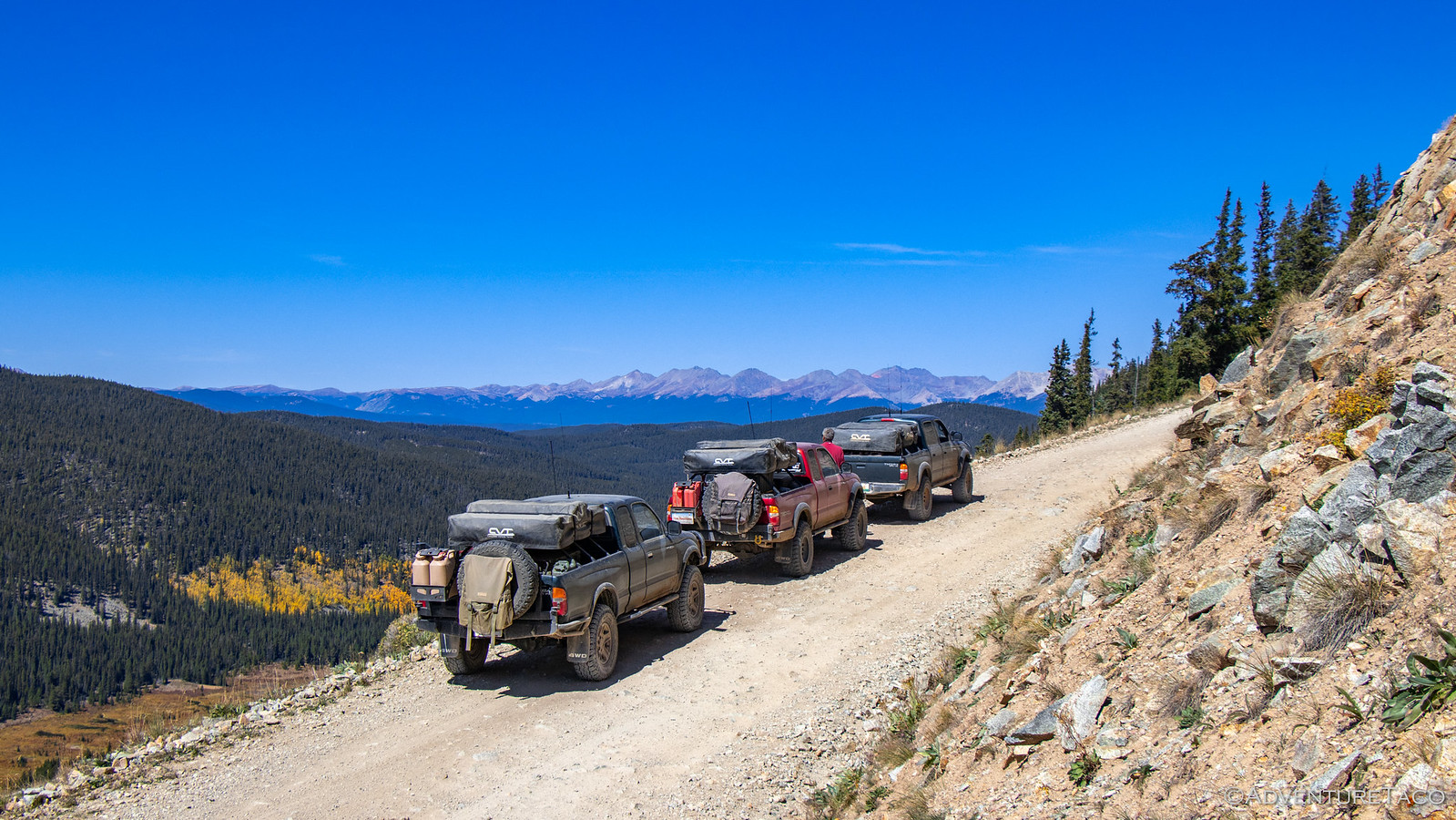

We climbed for miles, the road twisty and fun as it hugged the side of the mountain.

By the time we reached the top, we found ourselves above the treeline and 12,015 ft above sea level - the thin air now a regular occurrence, though I'm not sure we were going to be running any marathons at these elevations.


This would have been a great place to eat lunch, and on a normal day I might have glanced to see what time it was. But there was no need for that today, the half-pound of bacon in our bellies more than enough to keep us going at this point in the day. So keep going we did, down the south side of the mountain, past old mine buildings and their tailings, alongside streams with clear still pools sparkling in the sun.

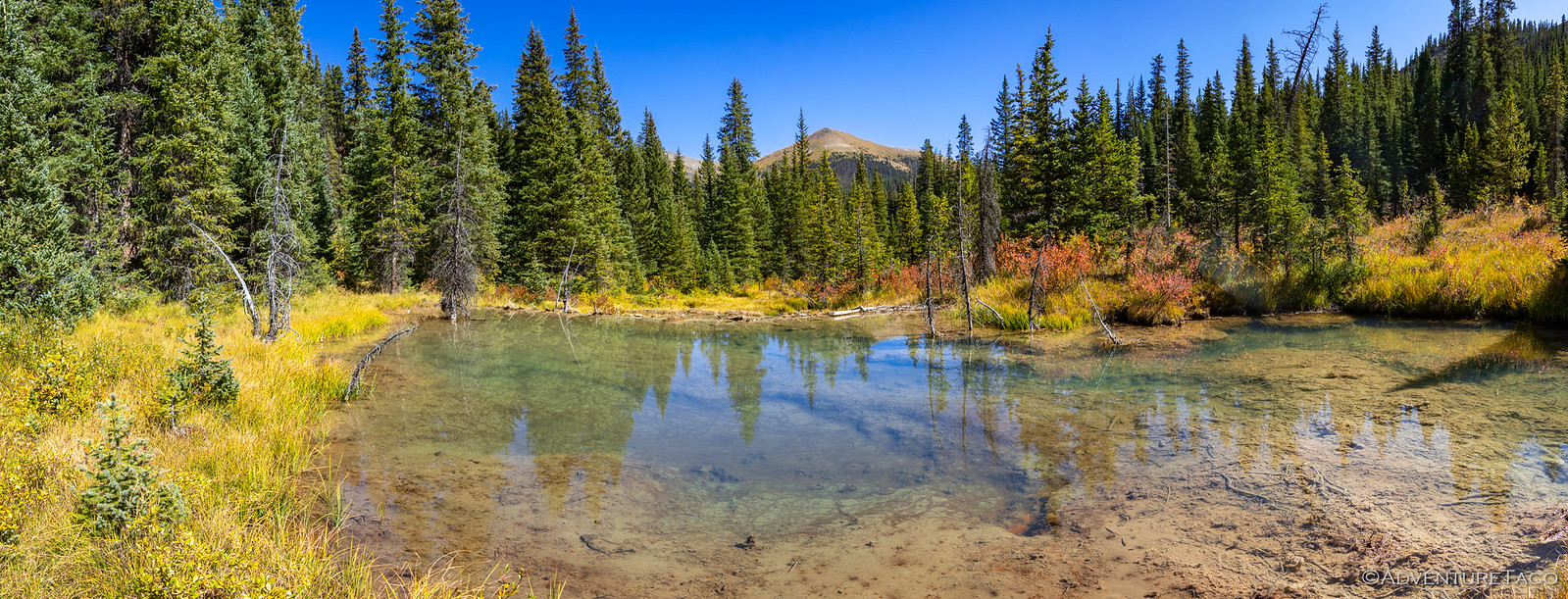
As we neared the bottom, Mike pulled over on a small offshoot. For days we'd been driving through landscapes full of beaver activity - dams, ponds, and lodges - and we'd always said we'd stop at the next one. Well, here we were at the 42nd next one, so it must finally have been time. ?

Don't miss the rest of the story, and all the remaining photos that don't fit here (due to max post size). Hopefully that can change in the future, but until then...
.
The day started out like any other. I was up a little before sunrise looking for color, and while there wasn't much, I did get a little splash on the horizon that seemed to mimic the angle of Brett @Squeaky Penguin's GFC.

While the clear skies may have minimized the colorful sunrise, they did mean that morning in camp was a rather pleasant affair, the views back towards the Collegiate Peaks a striking way to enjoy the warming sun.

And then - just as we were enjoying the peace and tranquility and our trucks and tents were thawing out - a low-flying chopper buzzed our site. We still have no idea where he was headed, really - but we were sure that he hadn't made any friends with the elk hunters who were out in force!


Now, unlike most mornings, this wasn't one where our regular routines were going to suffice. I mean sure, Mike @Digiratus and Brett still made their coffee - and sure, our tents were all eventually put away. But between those two things, we took the time to cook a dozen eggs, a skillet full of potatoes, and two pounds of the most delicious Big Buy bacon.
And then - on Brett's last morning in camp - we feasted.

Of course, after any meal like that, a nap is the next item on the agenda. We didn't actually climb back in our tents, but we did sit around for a couple hours, soaking up the sun and enjoying each other's company as we watched a parade of UTVs and full-size pickups make their way slowly along the road.
It was after noon when Brett finally bid farewell, the rest of us not far behind as we pulled out of camp to get underway - our destination today to the south and east, as our fourth made his way north towards home.

Our southern route would take us to the tiny town of Tin Cup, and from there to Cumberland Pass. And, since I know it's on the top of your mind - let me assure you that our progress was no faster as a result of our late start - even Mike soaking up the fall colors that were blossoming around us.



Tin Cup was a town similar to Montezuma - it was small and quaint, it's roads made of dirt. Founded in 1878 when lode deposits were discovered in the area, it was originally named Virginia City. By the 1880 census, the town had a population of 1,495 but confusion with Virginia City, Nevada, and Virginia City, Montana, caused the residents to change the name to Tin Cup - named after prospector Jim Taylor panned some gold from Willow Creek, and carried it back to camp in a tin cup.
For many years, Tin Cup was a violent place. Town marshal Harry Rivers died in a gunfight in 1882, and marshal Andy Jameson was shot to death in 1883. The town population declined as the mines were exhausted and the post office closed in 1918, the last year any town elections were held. (wikipedia)

Through town, we started up Cumberland Pass, the additional height quickly giving us a birds eye view of the valley we'd just traversed.


We climbed for miles, the road twisty and fun as it hugged the side of the mountain.

By the time we reached the top, we found ourselves above the treeline and 12,015 ft above sea level - the thin air now a regular occurrence, though I'm not sure we were going to be running any marathons at these elevations.


This would have been a great place to eat lunch, and on a normal day I might have glanced to see what time it was. But there was no need for that today, the half-pound of bacon in our bellies more than enough to keep us going at this point in the day. So keep going we did, down the south side of the mountain, past old mine buildings and their tailings, alongside streams with clear still pools sparkling in the sun.


As we neared the bottom, Mike pulled over on a small offshoot. For days we'd been driving through landscapes full of beaver activity - dams, ponds, and lodges - and we'd always said we'd stop at the next one. Well, here we were at the 42nd next one, so it must finally have been time. ?

Don't miss the rest of the story, and all the remaining photos that don't fit here (due to max post size). Hopefully that can change in the future, but until then...
Keep reading the rest here
Redhead Down #9: The Last Hour
Redhead Down #9: The Last Hour
.
turbodb
Well-known member
Redhead Down #10: Dealing with the Fallout
Still unsure exactly what the day would hold, we were up before 9:00am to get an early start on figuring out how to get the Redhead home. As we broke down camp, I happened to notice that if I stood in just the right place, I got a single bar of Internet on my phone, and soon enough we'd done a bunch of research that made us all feel quite a bit better.

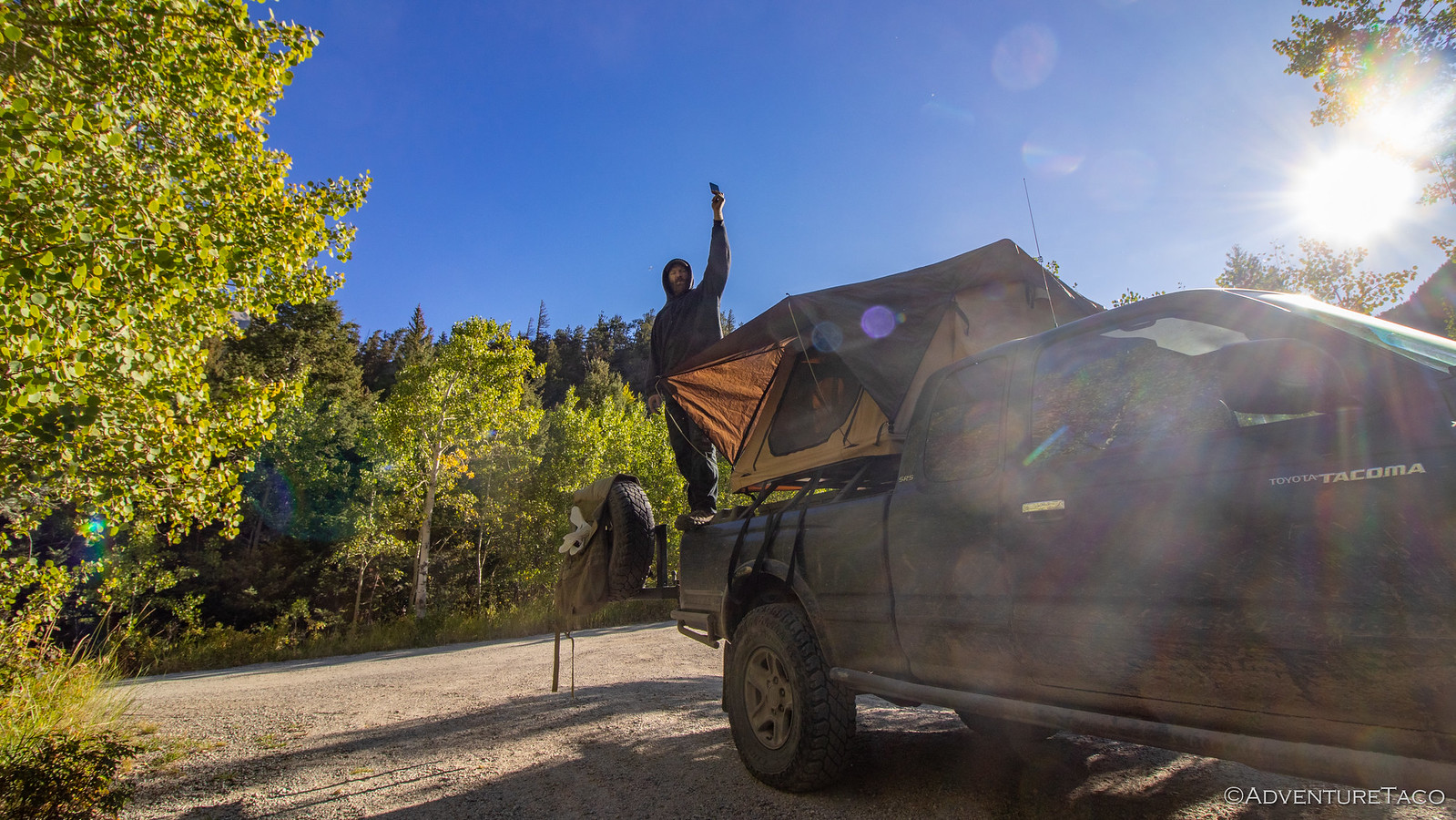
I was able to download my 1st gen Tacoma parts list and to our surprise, shock towers were a separately orderable part - great news since we were worried that they might only be acquirable as part of a full frame! At the same time, we were able to research the feasibility of a U-Haul rental for the Redhead, and it looked like that might be doable in Buena Vista - the nearest town - rather than requiring a drive several hours to Denver.
And the Redhead - looking as sad as we've seen her - wasn't going to make it to Denver.

With the good news, we got done packing up and Mike @Digiratus led the way towards town, with Monte @Blackdawg in the middle and me following at a distance with my hazards flashing.

We made a beeline to the U-Haul, hoping they'd have both an auto-transport trailer as well as a 10' van to pull it. The van was there, but it turned out the trailer was located half an hour south in the town of Salida, so we locked up the Redhead and hopped in the two green trucks for the journey.

It was on this trip south that two notable events took place. First, the Tacoma hit 130,000 miles. That's still baby steps for a 20 year old Tacoma, but it was just a couple years ago that I hit 60,000 miles, so there've been quite a few adventures in that time!

The second event was a bit less momentous, but perhaps more predictable. See, since the evening before - about the same time Mike and I had our troubles - Monte had been feeling that his steering was just a little sloppy. He wasn't sure what the problem was exactly, but the truck would pull right as he braked. As we waited for Mike to get all set with the trailer, he figured he might as well check his lower ball joints (LBJs).
It wasn't a pretty sight.

That grease isn't even from the LBJ itself - it's from the lower control arm (LCA) below the joint. And that meant that the joint itself was nearly dry. Had the joints let go on the trail, Monte could have had the most serious breakdown of us all!
At any rate, we hooked the trailer up to my truck and started back to Buena Vista - where we'd eat lunch and then load up the Redhead for the long trip home.


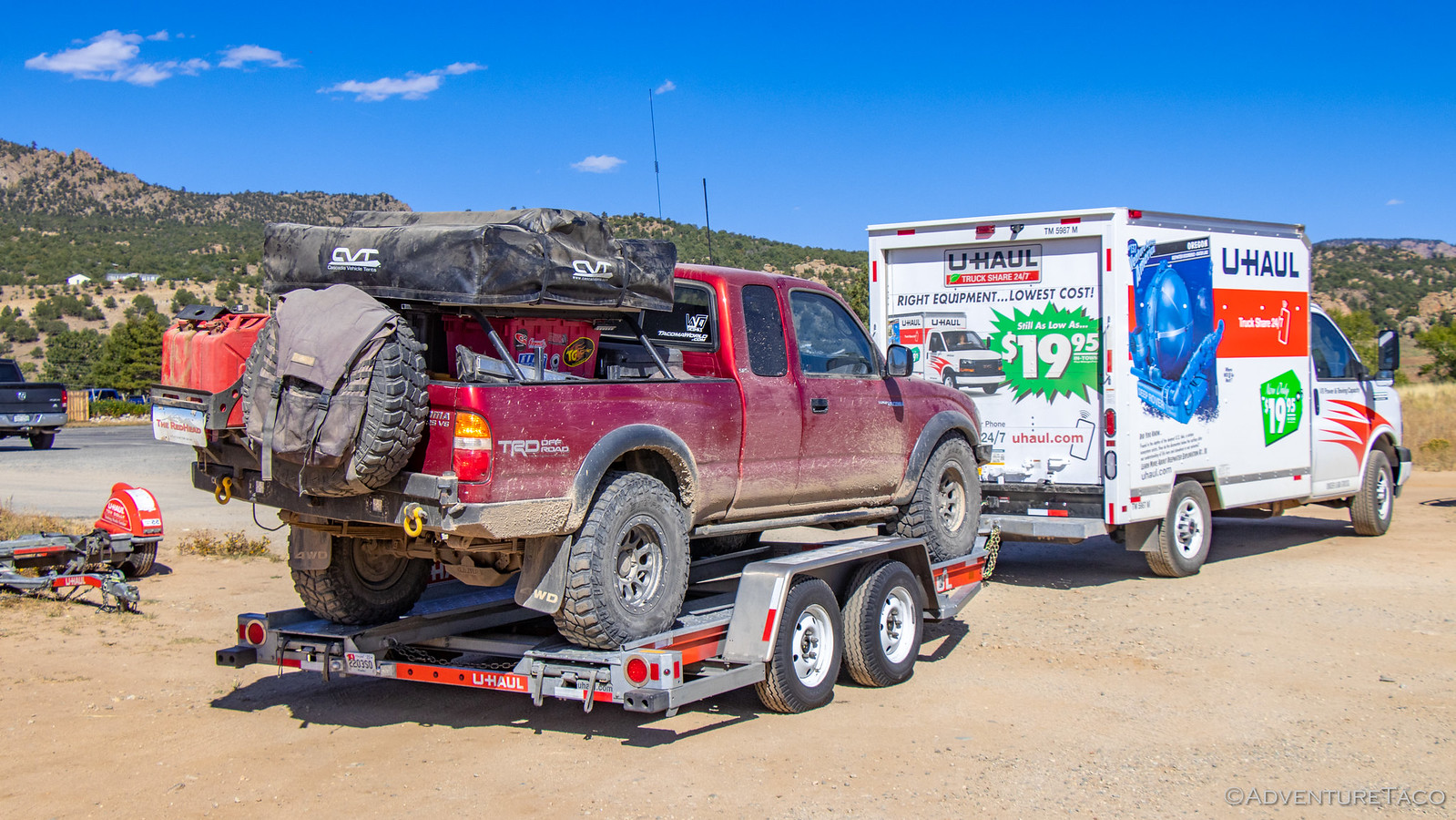
It wasn't a complex affair, but it did take a bit of time to secure everything in a way that we were reasonably happy - the winch pulling the truck forward, heavy duty straps attached in the rear. And with that, Mike pulled out of the U-Haul lot, the Redhead in tow.

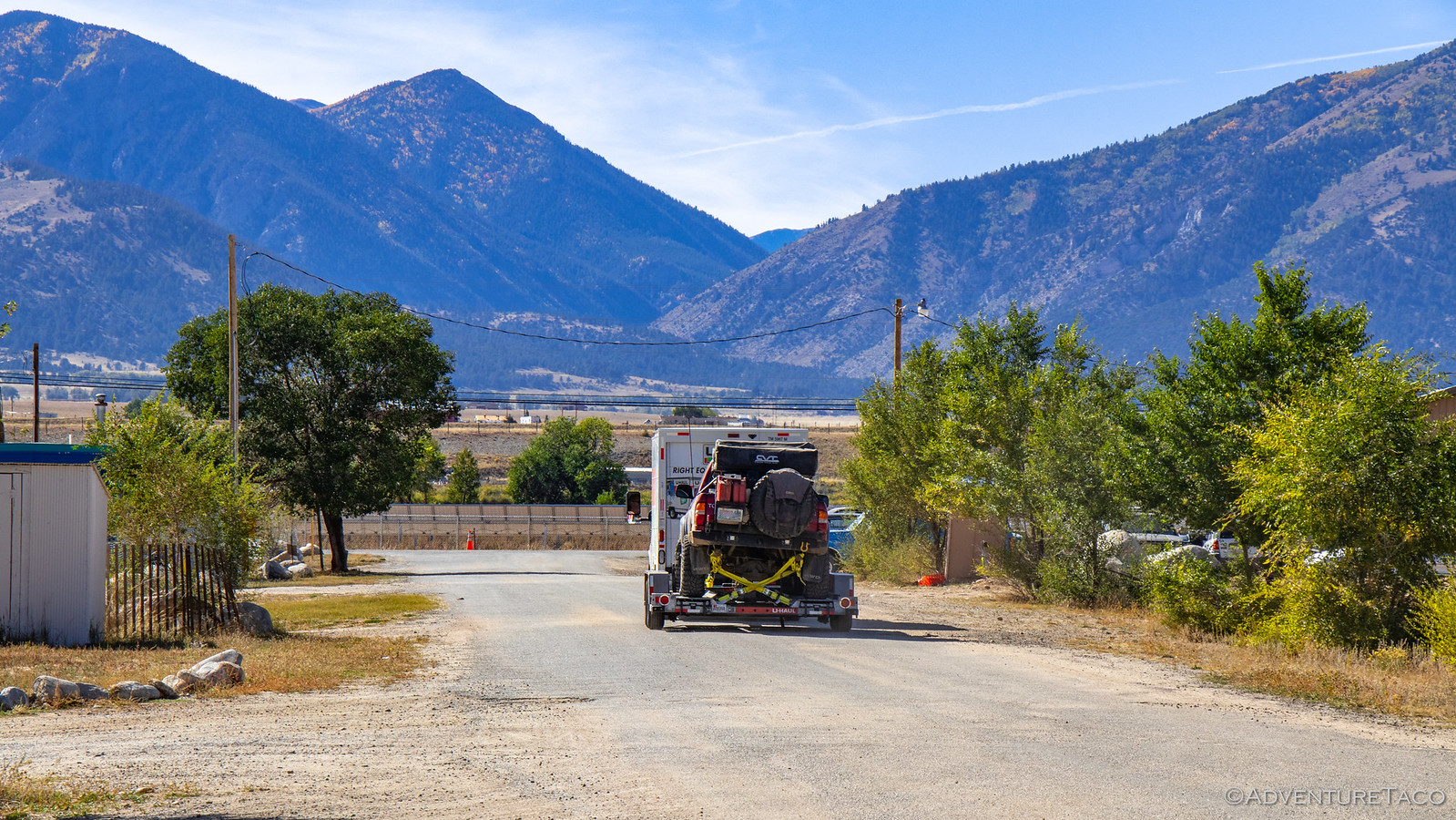
We weren't - however - headed home yet. In fact, Monte and I had planned to let Mike get a head start home while he and I returned to Mt. Antero to bag our 14er, but Monte's LBJ discovery had put a kibosh on that plan. Instead, all three of us high-tailed it over to the local town park where Monte could more closely evaluate his situation, and try to make it work for his journey home.
Except he never got that far. Just a block from the park flashing lights lit up behind him. The local sheriff had seen his IGOR license plate and was wondering what the heck was going on. ?
As Monte tells the story, his response started something like, "There's a bit of a story there sir, so bear with me..." and he then recounted how the plates save us a bunch of time when editing photos on these amazing journeys. The sheriff was quite appreciative of the situation, and after checking to make sure Monte's registration was in order, complemented all of us on our trucks and wished us a safe journey.
Pretty cool dude.
And then Monte dug into the ball joints.

In the end, the problem was obvious. The new Solo LCAs he'd purchased - the beefy ones that were going to make his alignments easy and that he never failed to remind us were so much better than OEM - were simply too thin where the stud of the balljoint passed through them. That meant that the lower castle nut could never fully tighten - something he'd missed during install. Both of them had nearly worked their way off when he finally discovered them, disaster likely only a tank or two of gas away!
Luckily, the solution was nearly as obvious as the problem. Or at least, the immediate solution was. We headed over to the local Tractor Supply and purchased several thick, grade 8, lock washers. With these slipped over the studs, we could effectively increase the thickness of the LCA, allowing him to snug up the castle nuts and correctly install the cotter pins.
It was a hack - and not the level of quality he'd expected from Solo - but it worked in a pinch, and within a couple hours, everything was buttoned back up and the truck was once again roadworthy - at least for a short time.


By now it was 5:30pm - as often seems to be the case, trail fixes taking much of whatever day they are started on - and we knew there was no hope of getting to the summit of Mt. Antero before the sun set. That left only one thing for us to do - continue as battered band of Tacomas - towards home.
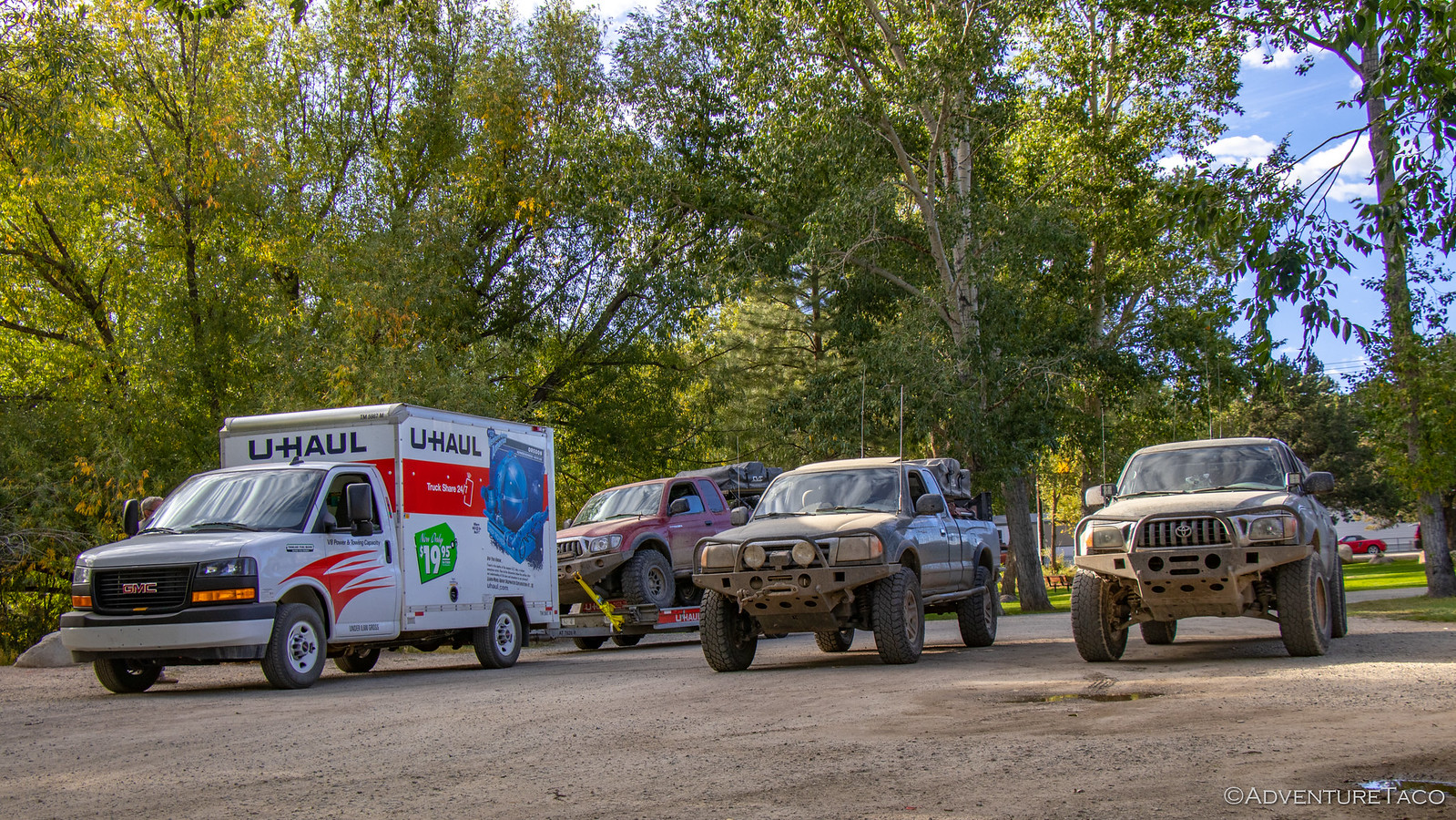
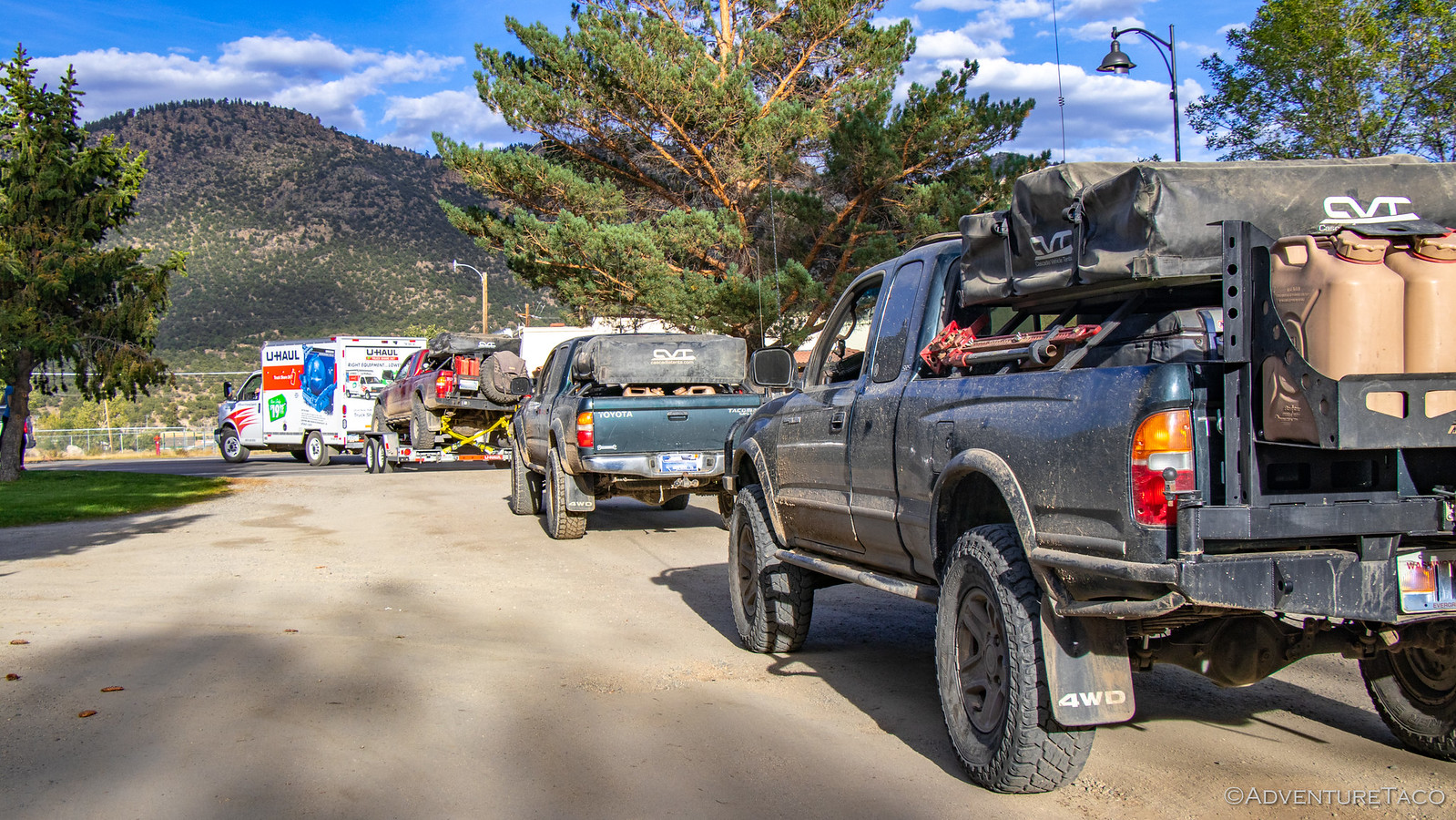
We'd travel together for four hours or so that evening - into the sunset as it were - Mike and the Redhead leading the way. Monte and I got the best gas mileage ever - at just over 22mpg - our route losing 7,000 ft of elevation and kept to 55mph.

We'd come to Colorado for an unforgettable adventure - and that's just what we'd had. And as always seems to be the case, we left plenty to explore on a return trip!
Still unsure exactly what the day would hold, we were up before 9:00am to get an early start on figuring out how to get the Redhead home. As we broke down camp, I happened to notice that if I stood in just the right place, I got a single bar of Internet on my phone, and soon enough we'd done a bunch of research that made us all feel quite a bit better.


The Internet is better up here.
I was able to download my 1st gen Tacoma parts list and to our surprise, shock towers were a separately orderable part - great news since we were worried that they might only be acquirable as part of a full frame! At the same time, we were able to research the feasibility of a U-Haul rental for the Redhead, and it looked like that might be doable in Buena Vista - the nearest town - rather than requiring a drive several hours to Denver.
And the Redhead - looking as sad as we've seen her - wasn't going to make it to Denver.

With the good news, we got done packing up and Mike @Digiratus led the way towards town, with Monte @Blackdawg in the middle and me following at a distance with my hazards flashing.

We made a beeline to the U-Haul, hoping they'd have both an auto-transport trailer as well as a 10' van to pull it. The van was there, but it turned out the trailer was located half an hour south in the town of Salida, so we locked up the Redhead and hopped in the two green trucks for the journey.

It was on this trip south that two notable events took place. First, the Tacoma hit 130,000 miles. That's still baby steps for a 20 year old Tacoma, but it was just a couple years ago that I hit 60,000 miles, so there've been quite a few adventures in that time!

The second event was a bit less momentous, but perhaps more predictable. See, since the evening before - about the same time Mike and I had our troubles - Monte had been feeling that his steering was just a little sloppy. He wasn't sure what the problem was exactly, but the truck would pull right as he braked. As we waited for Mike to get all set with the trailer, he figured he might as well check his lower ball joints (LBJs).
It wasn't a pretty sight.

That grease isn't even from the LBJ itself - it's from the lower control arm (LCA) below the joint. And that meant that the joint itself was nearly dry. Had the joints let go on the trail, Monte could have had the most serious breakdown of us all!
At any rate, we hooked the trailer up to my truck and started back to Buena Vista - where we'd eat lunch and then load up the Redhead for the long trip home.



It wasn't a complex affair, but it did take a bit of time to secure everything in a way that we were reasonably happy - the winch pulling the truck forward, heavy duty straps attached in the rear. And with that, Mike pulled out of the U-Haul lot, the Redhead in tow.


We weren't - however - headed home yet. In fact, Monte and I had planned to let Mike get a head start home while he and I returned to Mt. Antero to bag our 14er, but Monte's LBJ discovery had put a kibosh on that plan. Instead, all three of us high-tailed it over to the local town park where Monte could more closely evaluate his situation, and try to make it work for his journey home.
Except he never got that far. Just a block from the park flashing lights lit up behind him. The local sheriff had seen his IGOR license plate and was wondering what the heck was going on. ?
As Monte tells the story, his response started something like, "There's a bit of a story there sir, so bear with me..." and he then recounted how the plates save us a bunch of time when editing photos on these amazing journeys. The sheriff was quite appreciative of the situation, and after checking to make sure Monte's registration was in order, complemented all of us on our trucks and wished us a safe journey.
Pretty cool dude.
And then Monte dug into the ball joints.

In the end, the problem was obvious. The new Solo LCAs he'd purchased - the beefy ones that were going to make his alignments easy and that he never failed to remind us were so much better than OEM - were simply too thin where the stud of the balljoint passed through them. That meant that the lower castle nut could never fully tighten - something he'd missed during install. Both of them had nearly worked their way off when he finally discovered them, disaster likely only a tank or two of gas away!
Luckily, the solution was nearly as obvious as the problem. Or at least, the immediate solution was. We headed over to the local Tractor Supply and purchased several thick, grade 8, lock washers. With these slipped over the studs, we could effectively increase the thickness of the LCA, allowing him to snug up the castle nuts and correctly install the cotter pins.
It was a hack - and not the level of quality he'd expected from Solo - but it worked in a pinch, and within a couple hours, everything was buttoned back up and the truck was once again roadworthy - at least for a short time.


By now it was 5:30pm - as often seems to be the case, trail fixes taking much of whatever day they are started on - and we knew there was no hope of getting to the summit of Mt. Antero before the sun set. That left only one thing for us to do - continue as battered band of Tacomas - towards home.


We'd travel together for four hours or so that evening - into the sunset as it were - Mike and the Redhead leading the way. Monte and I got the best gas mileage ever - at just over 22mpg - our route losing 7,000 ft of elevation and kept to 55mph.

We'd come to Colorado for an unforgettable adventure - and that's just what we'd had. And as always seems to be the case, we left plenty to explore on a return trip!
turbodb
Well-known member
Rig Review: Whipsaw & Colorado 2019 - What worked and what didn't?
September 30, 2019.
It was another whirlwind of trips through August and September, with three more trips and 21 more nights now in the books: The Whipsaw Trail in BC, Canada, a trip with Pops to the California Sierras, and a nearly two-week adventure through Wyoming and Colorado. Of those, the two driving adventures both ended early due to mechanical failure of at least one vehicle on the trip, so without further ado, let's get into what's bound to be a stunning rig review!
Front Brake Hard Lines (long term)
TL;DR - the hard brakes lines are working fabulously and I'm happy to have installed them.
After the brake caliper failure on the IDBDR, I evaluated the Tundra brake situation and decided to complete the conversion to a Tundra front end from a brake perspective. That meant installing hard lines to the calipers, and replacing some of the mounting hardware on the spindles. It's worked out well, and I am now a firm supporter of this method of connecting the calipers to the rest of the hydraulic brake system.
As a reminder - LCE charges too much for the parts to do this, and they are essentially the only supplier. I will sell you the parts necessary to upgrade your brake lines for significantly less than LCE. If you are interested, check out the store page here: Tacoma-to-Tundra Hard Brake Line Upgrade Kit.

Rear Axle Seals
TL;DR - The rear axle seal replacement seems to worked beautifully and there is no more leaking at all.
My trip to Canada and the Whipsaw Trail was cut short when I discovered a leaky rear axle seal on the driver side. Upon my return, I replaced the seals using the Step-by-Step Guide to Replacing the Rear Axle Seals & Bearings I'd put together when doing the job on my 3rd gen 4Runner, and the project went off without a hitch. I hadn't driven the 4Runner much since doing the job, and the job on the Tacoma was done only a couple days before leaving for California and Colorado. I'm happy to report that through the entire 4500 mile journey, the seals worked flawlessly and I suspect will continue to work for another 100,000 miles or so. This is a job I entirely recommend doing yourself if you have the same problem - with the right tools, a little time, and the step-by-step guide above (which also links to the necessary parts and tools), it's easy and satisfying. Plus, you'll save yourself about $1000.

Little Hotties Hand Warmers
TL;DR - if you get cold hands/feet at night when it's cold outside, and would like to be warm and toasty in bed, these work great as long as they are exposed to air/moisture.
Perhaps even a year ago now, I purchased a box of Little Hotties Hand Warmers in the hopes that they would keep me warmer on really cold nights when we stayed up around the camp fire until way past my bedtime (midnight or so). I've used them a couple times since then, but I always tried putting them in my shoes as we were around the fire, and that never seemed to work - I think because they didn't have the necessary air flow to trigger the chemical reaction that gives off heat.
On the Colorado trip, I took a different approach. Instead of using them around the fire, I placed them in my socks when I got into bed. This way, they had more exposure to air. It worked great. They warmed right up and kept my feet warm for 8+ hours. That in turn kept me much more comfortable in bed. Will do again.
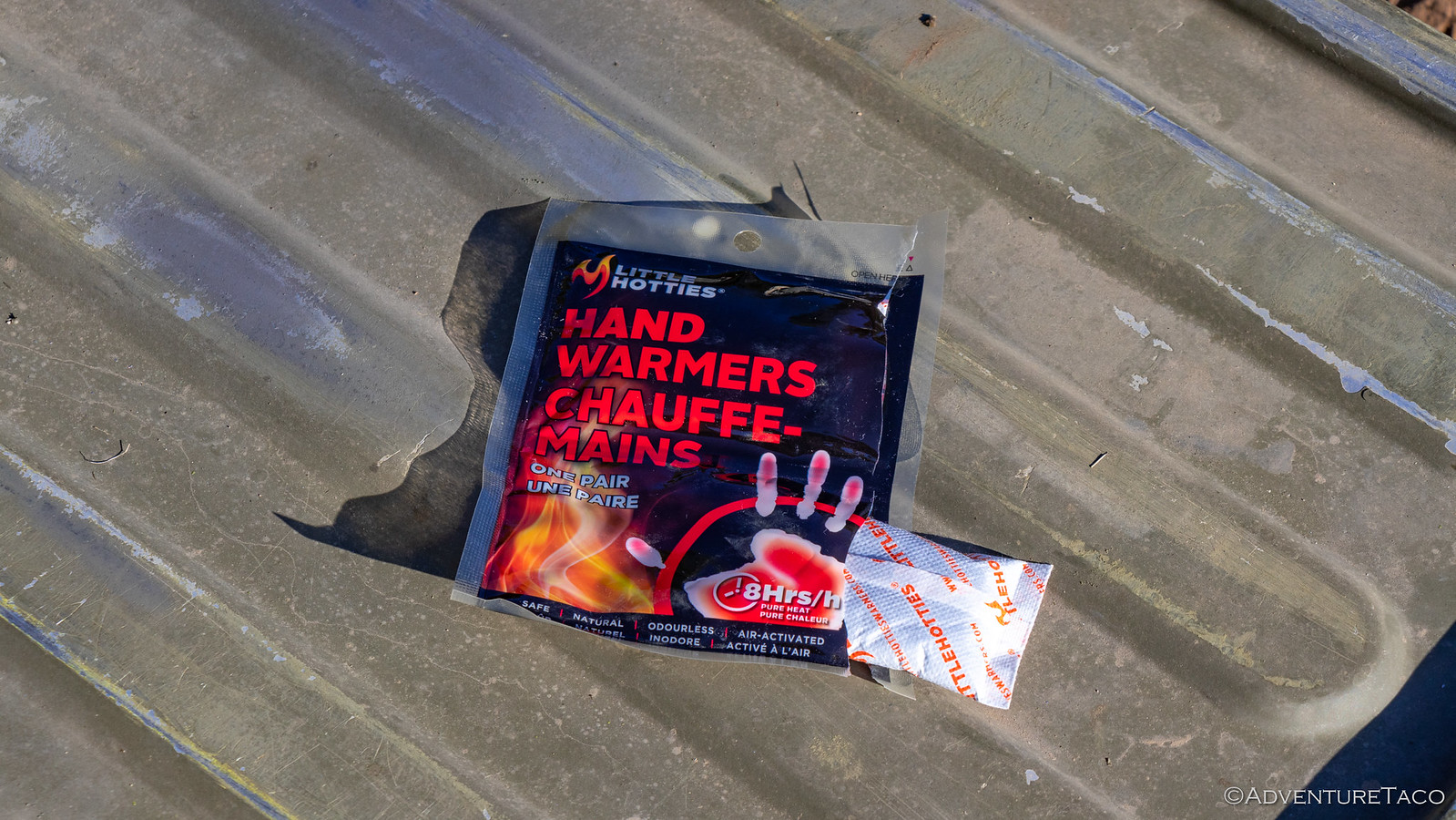
Front ADS Reservoirs Too Close to Tires
TL;DR - Moving the resis to the top of the frame means there is no more rubbing and I have my turning radius back.
It was many months ago that my tires started rubbing on the ADS reservoirs that I'd attached to the frame in the front wheel wells. This was a result of moving from SCS Stealth6 wheels to 4Runner 5-spoke wheels in order to reduce the amount of mud that was flung onto the truck in muddy conditions.
Until the trip to Colorado, I believed that my mounting location was the only one that the hose from the coilover to the resi would allow. However, I've since seen two other ADS owners who have installed their resis on the top of the frame, with seemingly positive results.
Also on the trip to Colorado, I noticed that the resis were starting to see significant wear from the rubbing. As such, immediately upon my return I moved the brackets and reservoirs to the top of the frame. This has solved the rubbing problem entirely, and though it's harder to access the resis when bolted to the top of the frame, I think it is a good long-term solution.
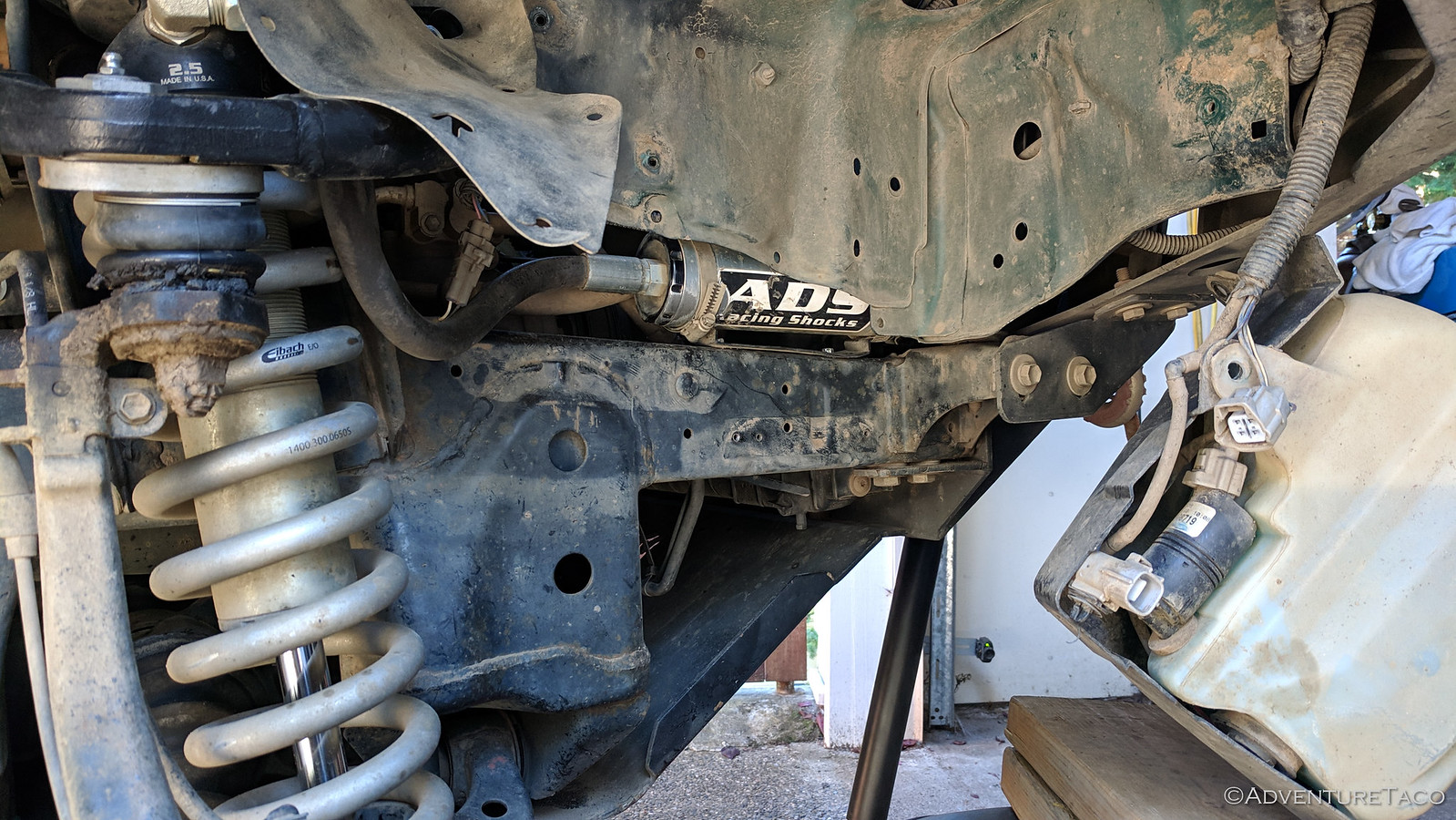
Front ADS Coilover Spherical Bearings (maintenance)
TL;DR - it's been about a year and my spherical bearings are getting squeaky; time to replace them.
My understanding is that these are COM10T bearings and that I can just look around on the internet and find the cheapest seller. Ugh, a plan like that always worries me a little bit.
Relentless Skid Plate Attachment
TL;DR - The skid plates are holding up, but the mounting strategy could have been better. For the 3rd time, I'm modifying it.
I had some significant trouble with the Relentless skid plates on the last trip to Colorado. I've always had an issue with the bolts in the rearmost mounts on the mid (transfer case) skid loosening up over time - I believe due to the fact that the bolts simply thread into the <1/8" frame, which is just too thin to really secure them.
Additionally, I've had a problem a year ago where the crossmember mounts sheared off, and had to be rewelded to the skid plate.
Both of these things were a problem this trip, and I also apparently ripped both bolts out of the IFS mounts on the front skid.

As a result, I'll be making the following modifications:
TL;DR - I have oil leaking from the transfer case where the front drive shaft attaches.
The truck is subjected to a lot of muddy water crossings and over time that muddy water gets in the various seals and things start to leak. That has happened on one of the transfer case seals, so I'll need to replace the seal between the transfer case and the front drive shaft. The part number for this is Transfer Case Oil Seal - Inner Front Drive Shaft (90311-41012) and I'll also need to replace the Transfer Case - Front Drive Shaft Stake Nut (90179-22016) at the same time.
The work isn't done yet, and I'm not overly worried at this point as the leak looks reasonably slow.

Overall Weight of the Tacoma
TL;DR - the truck is heavy at 5800 lbs loaded, and I need to find a way to shed weight. That's now on the project list for this winter.

Not technically my truck. Mine might be heavier.
.
September 30, 2019.
It was another whirlwind of trips through August and September, with three more trips and 21 more nights now in the books: The Whipsaw Trail in BC, Canada, a trip with Pops to the California Sierras, and a nearly two-week adventure through Wyoming and Colorado. Of those, the two driving adventures both ended early due to mechanical failure of at least one vehicle on the trip, so without further ado, let's get into what's bound to be a stunning rig review!
Front Brake Hard Lines (long term)
TL;DR - the hard brakes lines are working fabulously and I'm happy to have installed them.
After the brake caliper failure on the IDBDR, I evaluated the Tundra brake situation and decided to complete the conversion to a Tundra front end from a brake perspective. That meant installing hard lines to the calipers, and replacing some of the mounting hardware on the spindles. It's worked out well, and I am now a firm supporter of this method of connecting the calipers to the rest of the hydraulic brake system.
As a reminder - LCE charges too much for the parts to do this, and they are essentially the only supplier. I will sell you the parts necessary to upgrade your brake lines for significantly less than LCE. If you are interested, check out the store page here: Tacoma-to-Tundra Hard Brake Line Upgrade Kit.

Rear Axle Seals
TL;DR - The rear axle seal replacement seems to worked beautifully and there is no more leaking at all.
My trip to Canada and the Whipsaw Trail was cut short when I discovered a leaky rear axle seal on the driver side. Upon my return, I replaced the seals using the Step-by-Step Guide to Replacing the Rear Axle Seals & Bearings I'd put together when doing the job on my 3rd gen 4Runner, and the project went off without a hitch. I hadn't driven the 4Runner much since doing the job, and the job on the Tacoma was done only a couple days before leaving for California and Colorado. I'm happy to report that through the entire 4500 mile journey, the seals worked flawlessly and I suspect will continue to work for another 100,000 miles or so. This is a job I entirely recommend doing yourself if you have the same problem - with the right tools, a little time, and the step-by-step guide above (which also links to the necessary parts and tools), it's easy and satisfying. Plus, you'll save yourself about $1000.

Little Hotties Hand Warmers
TL;DR - if you get cold hands/feet at night when it's cold outside, and would like to be warm and toasty in bed, these work great as long as they are exposed to air/moisture.
Perhaps even a year ago now, I purchased a box of Little Hotties Hand Warmers in the hopes that they would keep me warmer on really cold nights when we stayed up around the camp fire until way past my bedtime (midnight or so). I've used them a couple times since then, but I always tried putting them in my shoes as we were around the fire, and that never seemed to work - I think because they didn't have the necessary air flow to trigger the chemical reaction that gives off heat.
On the Colorado trip, I took a different approach. Instead of using them around the fire, I placed them in my socks when I got into bed. This way, they had more exposure to air. It worked great. They warmed right up and kept my feet warm for 8+ hours. That in turn kept me much more comfortable in bed. Will do again.

Front ADS Reservoirs Too Close to Tires
TL;DR - Moving the resis to the top of the frame means there is no more rubbing and I have my turning radius back.
It was many months ago that my tires started rubbing on the ADS reservoirs that I'd attached to the frame in the front wheel wells. This was a result of moving from SCS Stealth6 wheels to 4Runner 5-spoke wheels in order to reduce the amount of mud that was flung onto the truck in muddy conditions.
Until the trip to Colorado, I believed that my mounting location was the only one that the hose from the coilover to the resi would allow. However, I've since seen two other ADS owners who have installed their resis on the top of the frame, with seemingly positive results.
Also on the trip to Colorado, I noticed that the resis were starting to see significant wear from the rubbing. As such, immediately upon my return I moved the brackets and reservoirs to the top of the frame. This has solved the rubbing problem entirely, and though it's harder to access the resis when bolted to the top of the frame, I think it is a good long-term solution.

Front ADS Coilover Spherical Bearings (maintenance)
TL;DR - it's been about a year and my spherical bearings are getting squeaky; time to replace them.
My understanding is that these are COM10T bearings and that I can just look around on the internet and find the cheapest seller. Ugh, a plan like that always worries me a little bit.
Relentless Skid Plate Attachment
TL;DR - The skid plates are holding up, but the mounting strategy could have been better. For the 3rd time, I'm modifying it.
I had some significant trouble with the Relentless skid plates on the last trip to Colorado. I've always had an issue with the bolts in the rearmost mounts on the mid (transfer case) skid loosening up over time - I believe due to the fact that the bolts simply thread into the <1/8" frame, which is just too thin to really secure them.
Additionally, I've had a problem a year ago where the crossmember mounts sheared off, and had to be rewelded to the skid plate.
Both of these things were a problem this trip, and I also apparently ripped both bolts out of the IFS mounts on the front skid.

As a result, I'll be making the following modifications:
- For the front skid IFS mounts, I'll be drilling out and re-tapping the mounts that I welded on to the LCA locations so that I can insert larger bolts. I'll also be welding a bit of a lip around the bolt heads to try and protect them more.
- For the mid skid, I'll be welding the crossmember mounts on again, and I'll just cross my fingers that they last another year. If/when they fail again, I may consider a different mounting strategy.
- For the mid skid, I'll be using Rivnuts to secure it to the frame in the rear-most position. I've already done this on the passenger side and it seemed to work well.
TL;DR - I have oil leaking from the transfer case where the front drive shaft attaches.
The truck is subjected to a lot of muddy water crossings and over time that muddy water gets in the various seals and things start to leak. That has happened on one of the transfer case seals, so I'll need to replace the seal between the transfer case and the front drive shaft. The part number for this is Transfer Case Oil Seal - Inner Front Drive Shaft (90311-41012) and I'll also need to replace the Transfer Case - Front Drive Shaft Stake Nut (90179-22016) at the same time.
The work isn't done yet, and I'm not overly worried at this point as the leak looks reasonably slow.

Overall Weight of the Tacoma
TL;DR - the truck is heavy at 5800 lbs loaded, and I need to find a way to shed weight. That's now on the project list for this winter.

Not technically my truck. Mine might be heavier.
.
turbodb
Well-known member
Oh yes we did! Really, it just meant that we had plenty of shop days to get together and have a good time to get the truck ready for the next season of trips!Truly wonderful expedition! Too bad about the issue but I'm you enjoyed every minute of it.
Nice! Looking forward to your next trip report.Oh yes we did! Really, it just meant that we had plenty of shop days to get together and have a good time to get the truck ready for the next season of trips!
Similar threads
- Replies
- 307
- Views
- 20K
- Replies
- 29
- Views
- 3K
